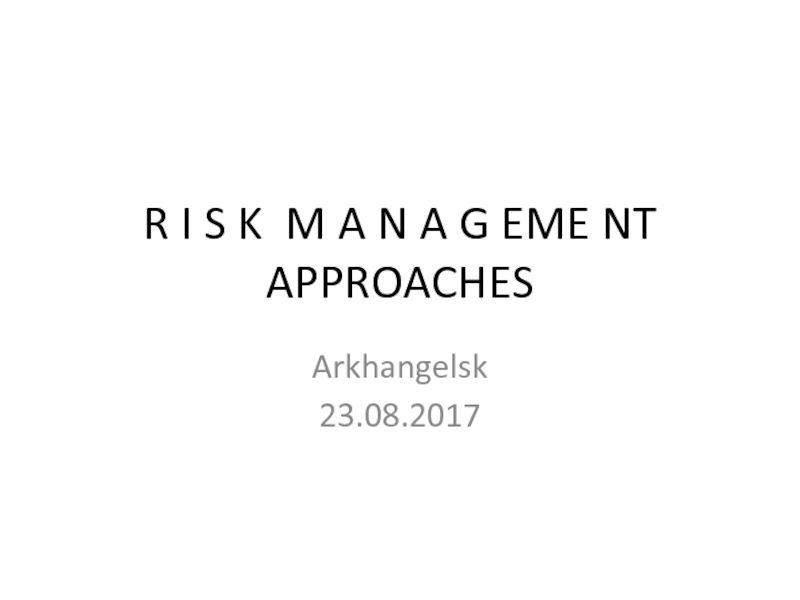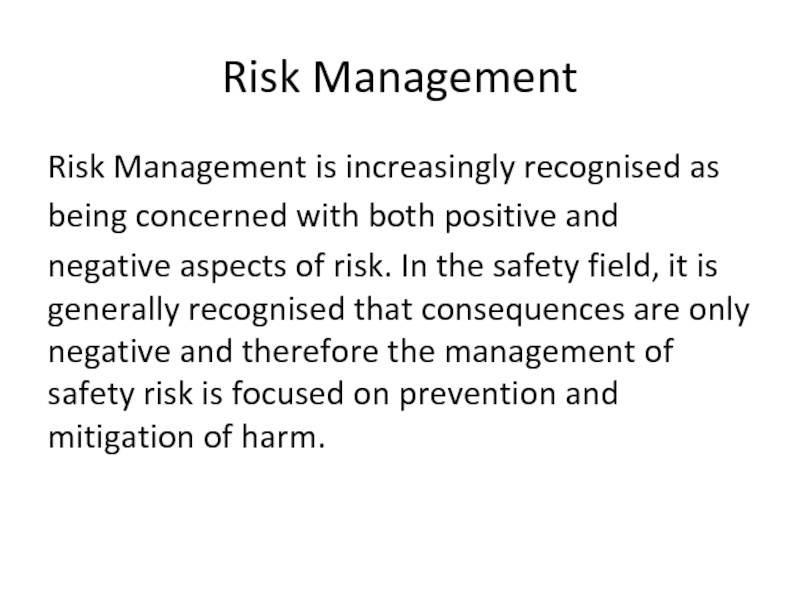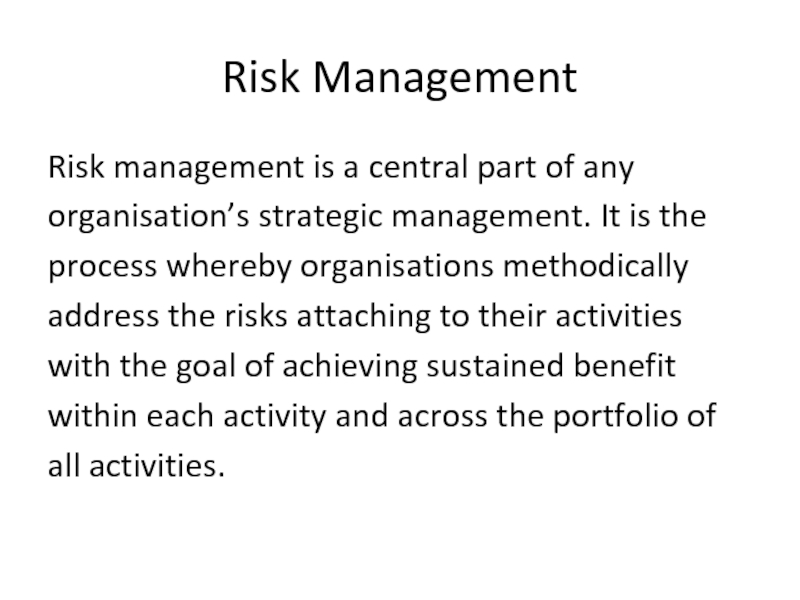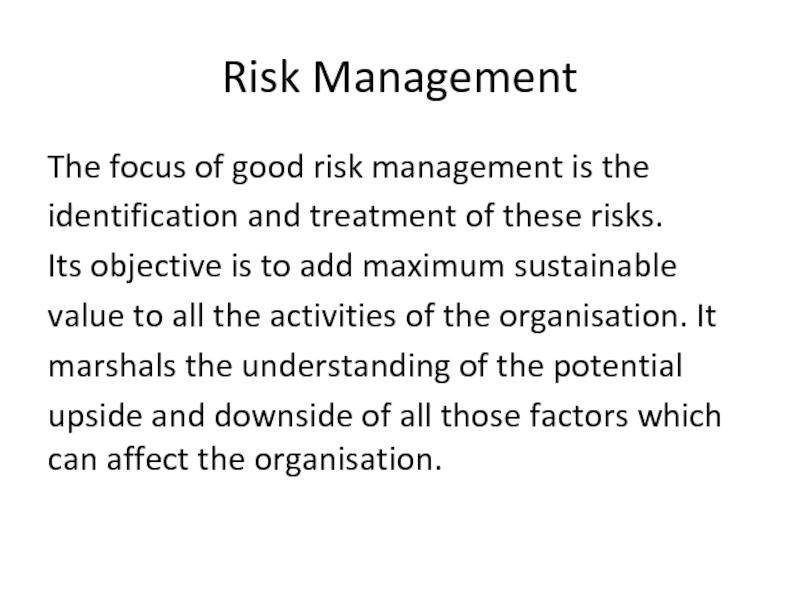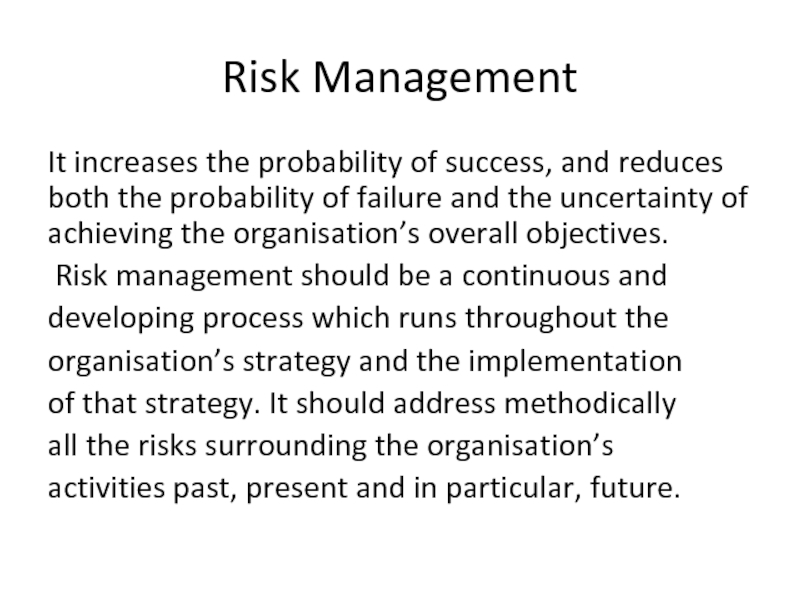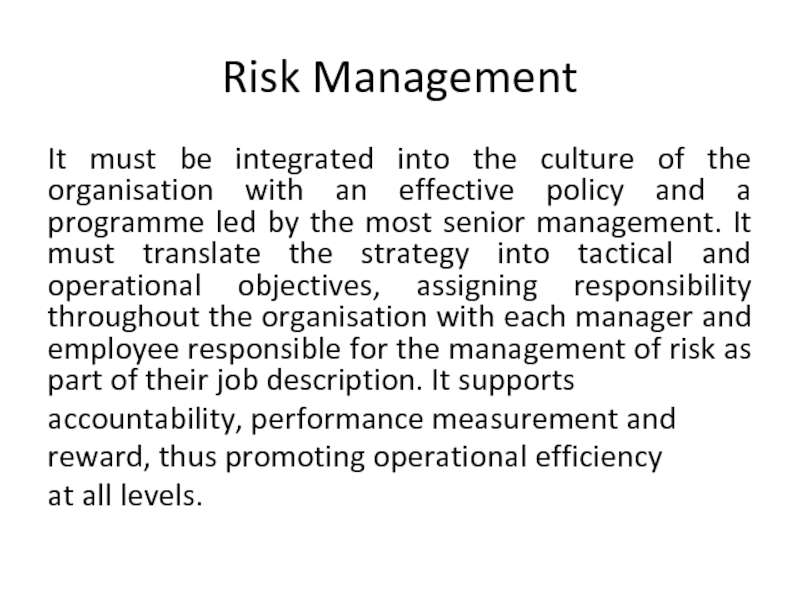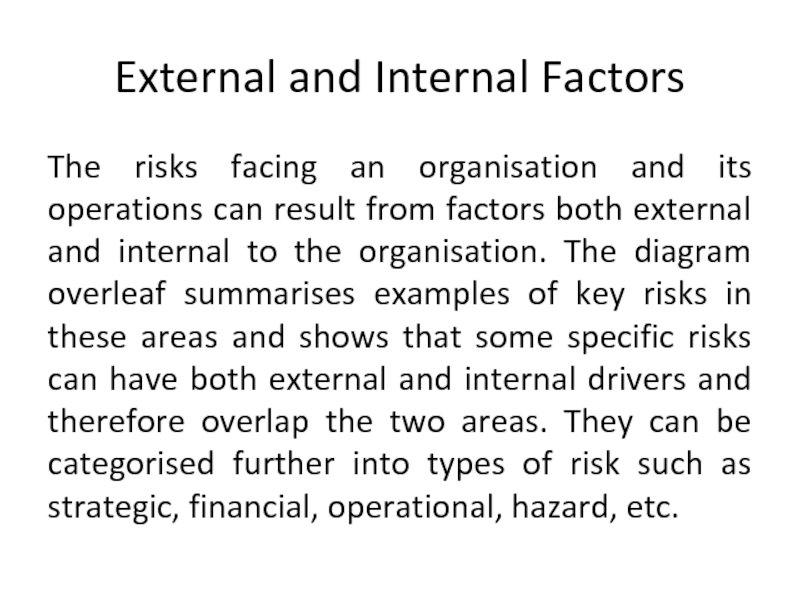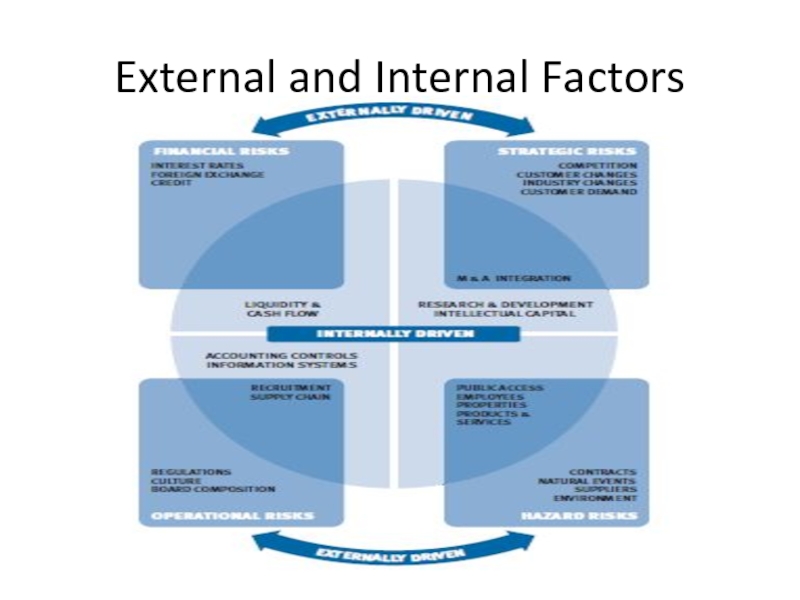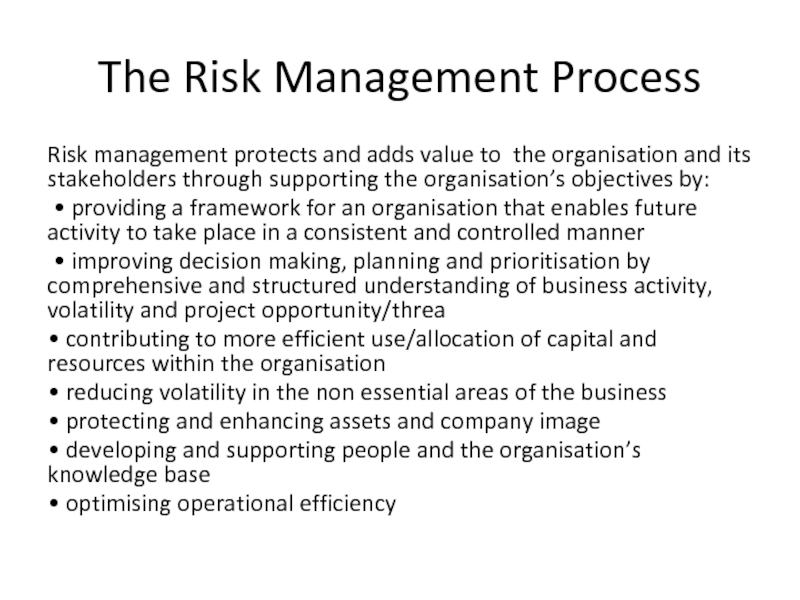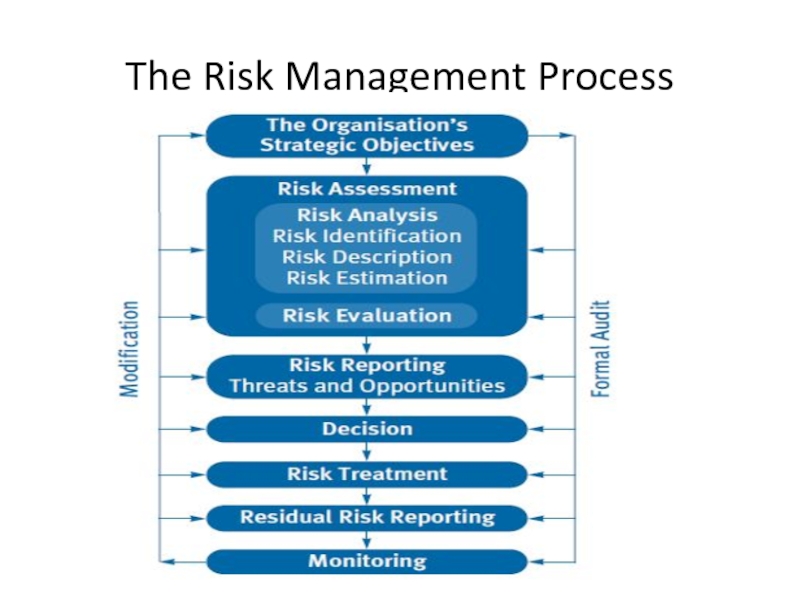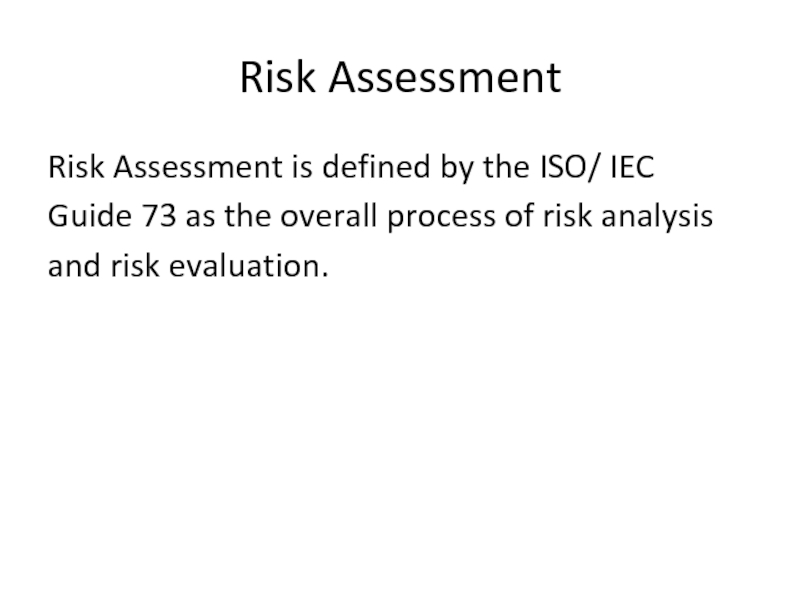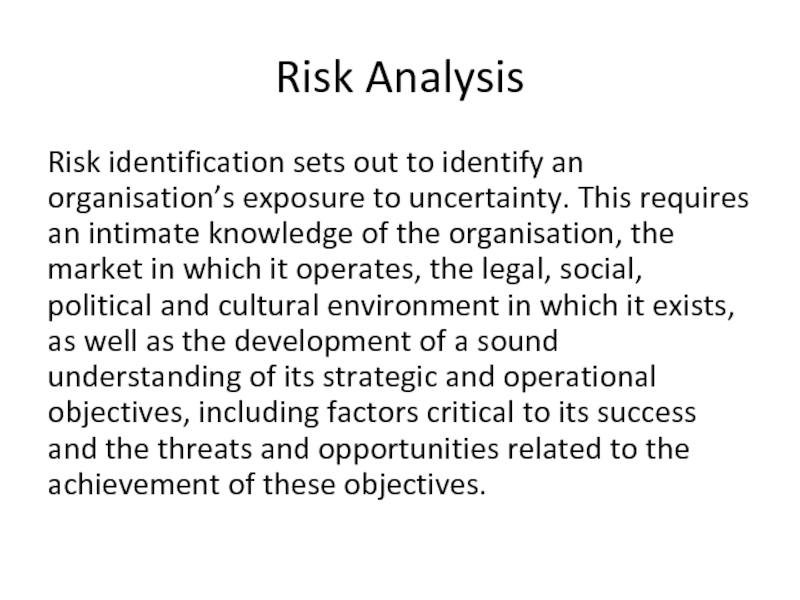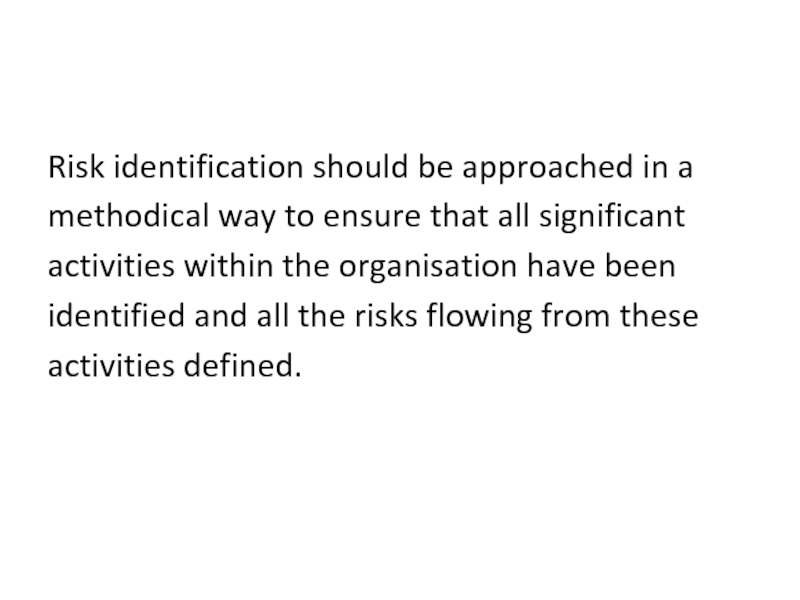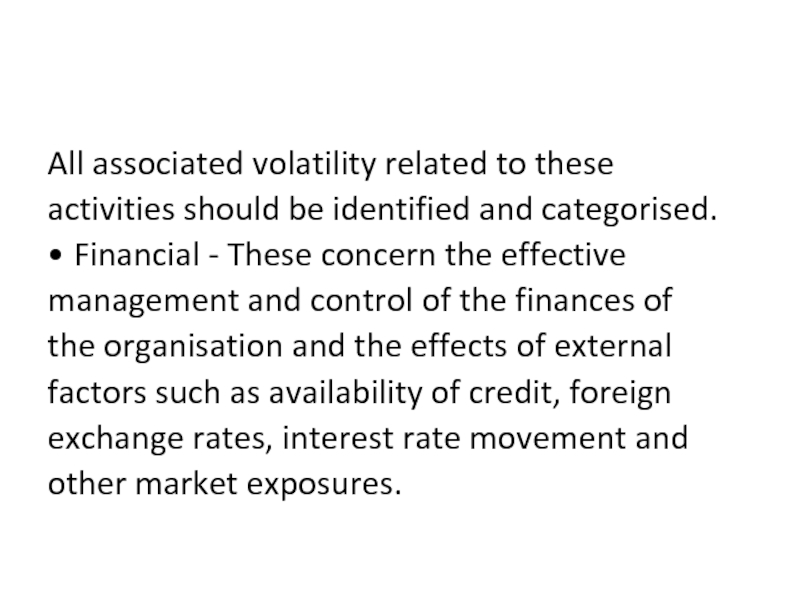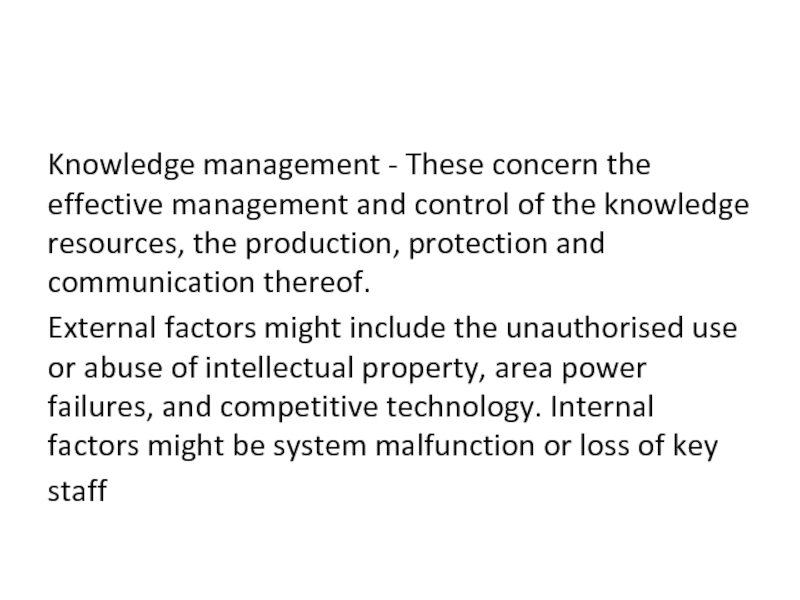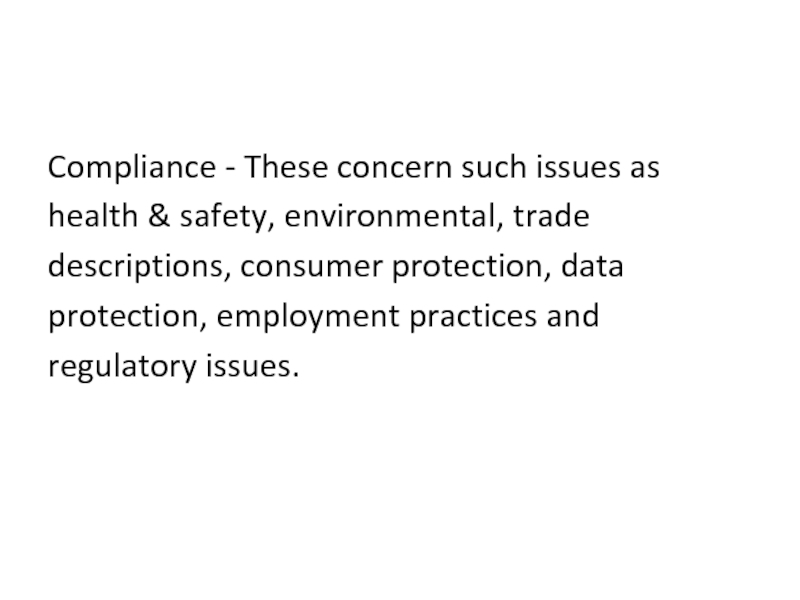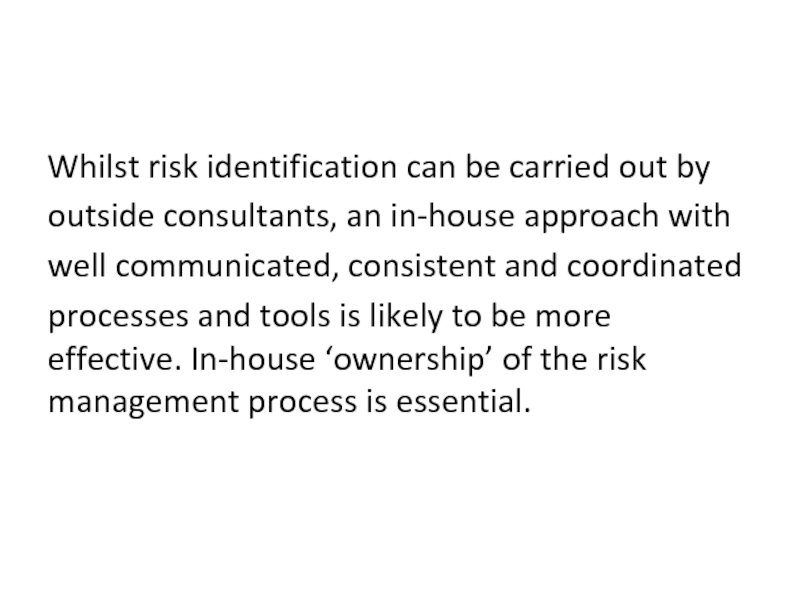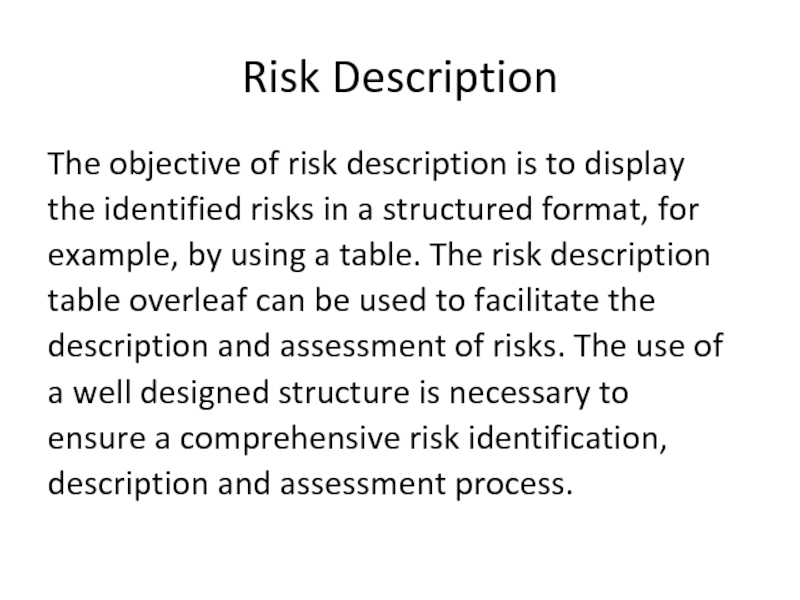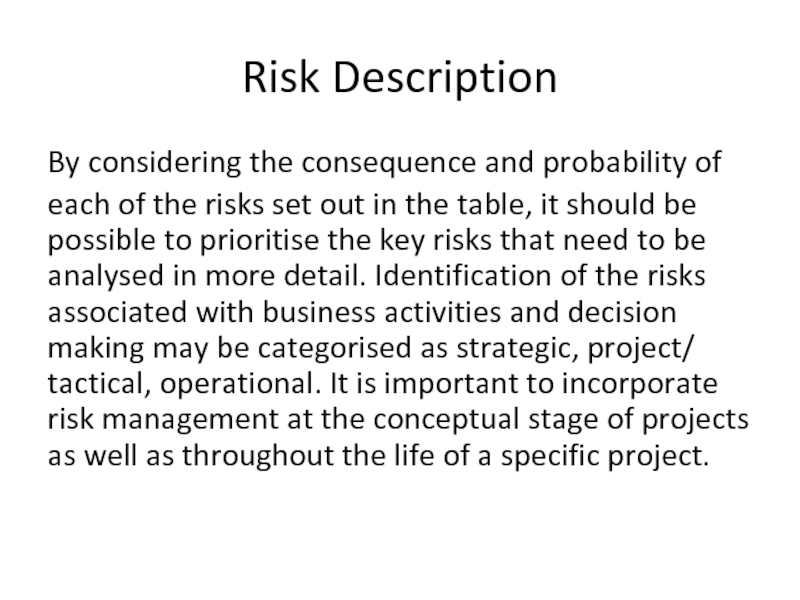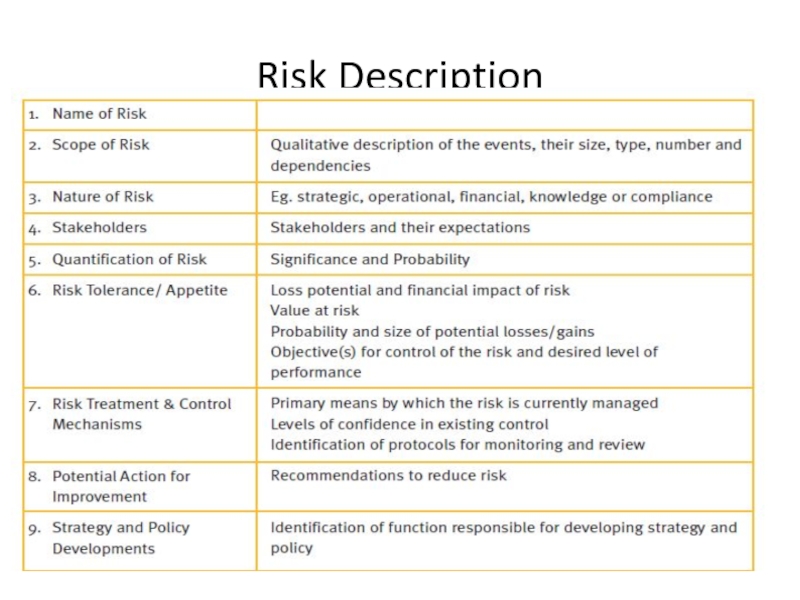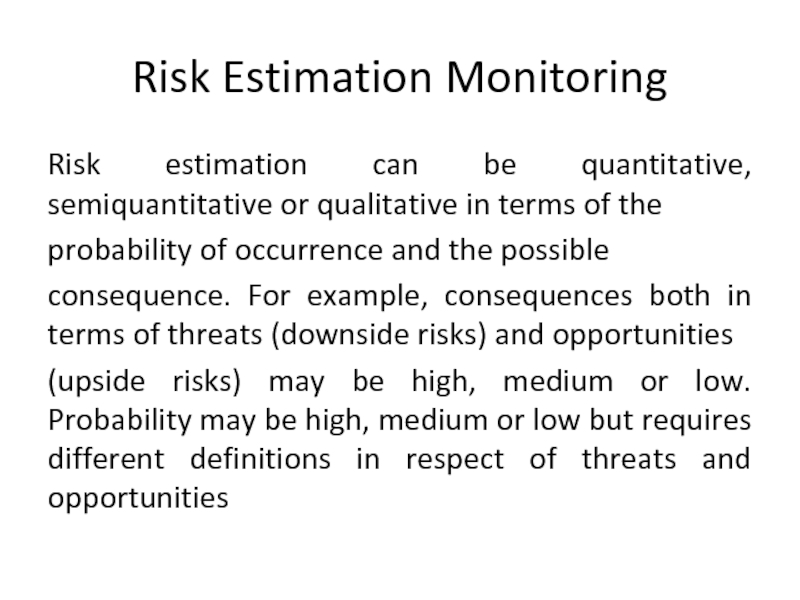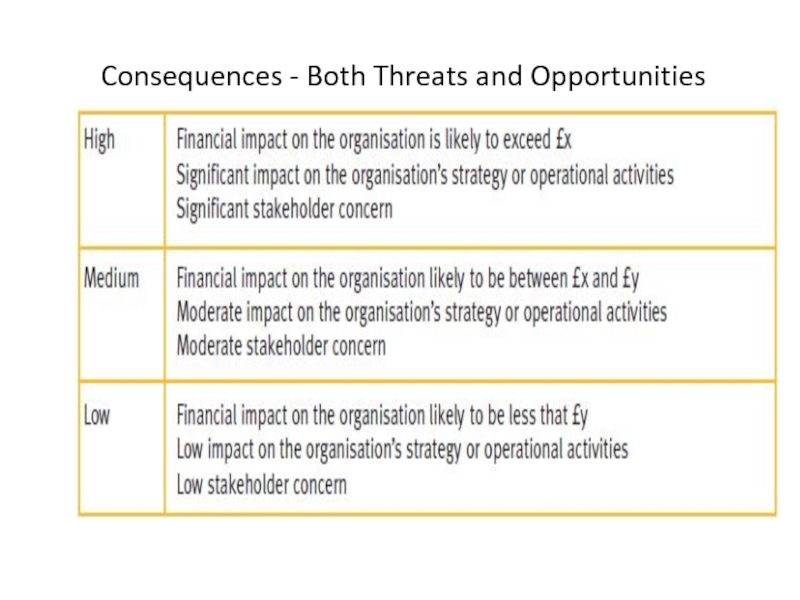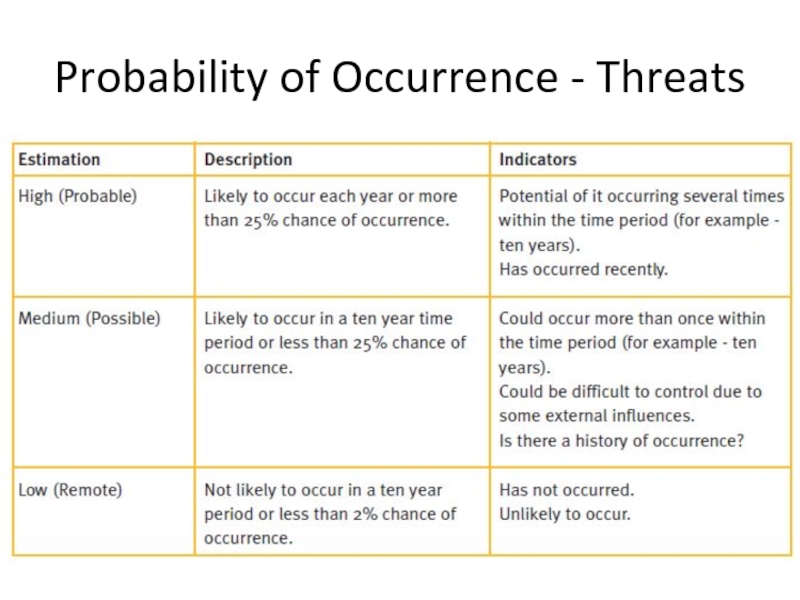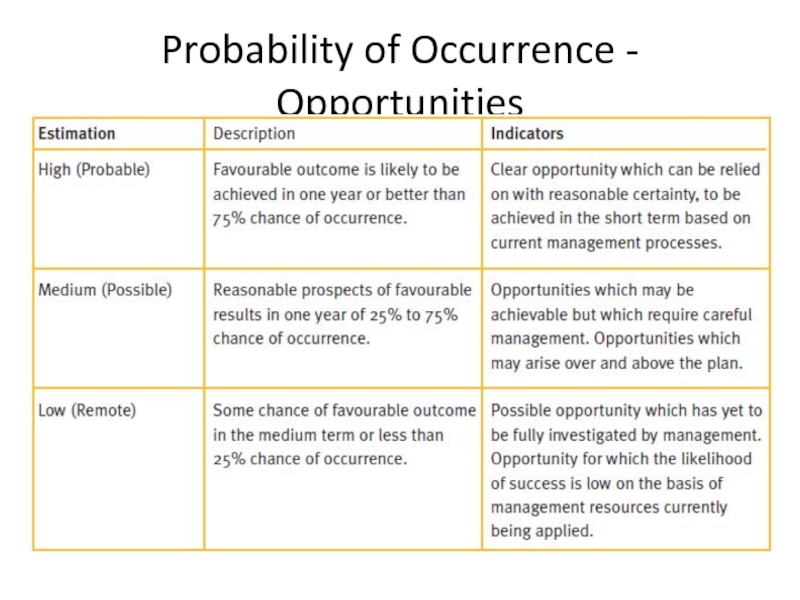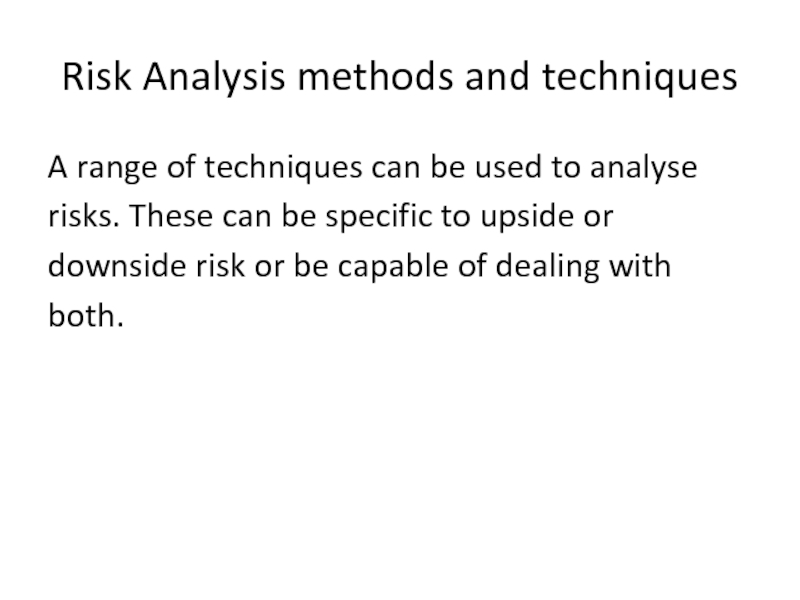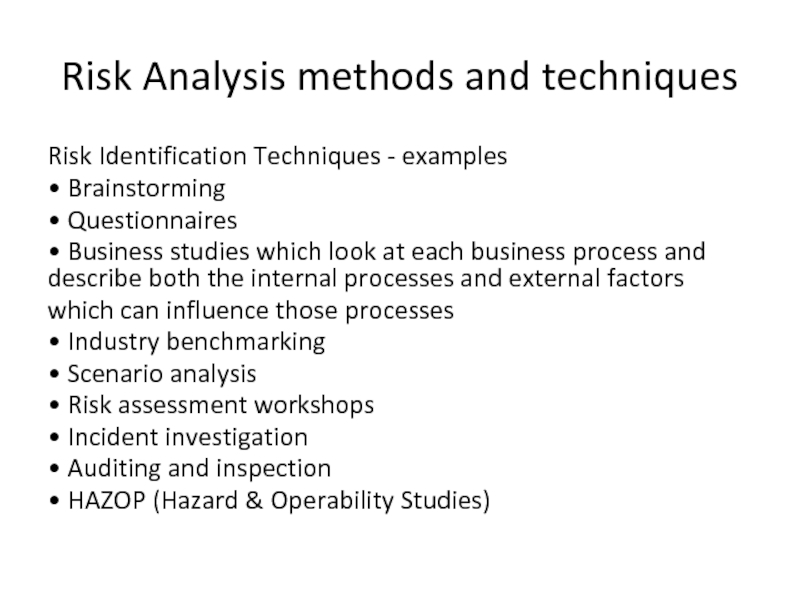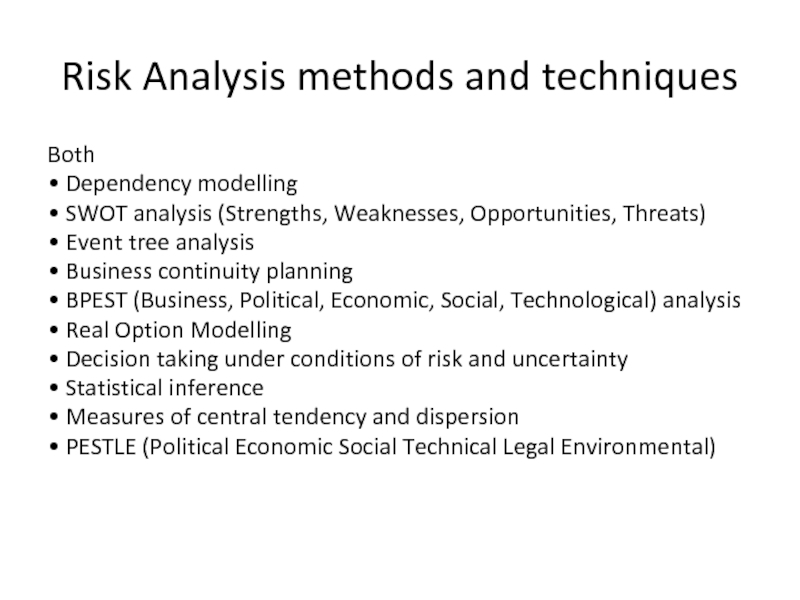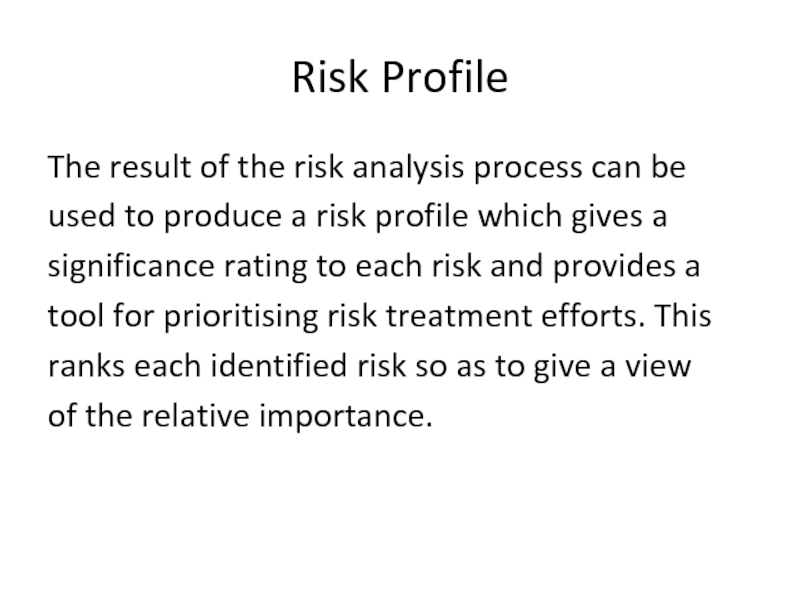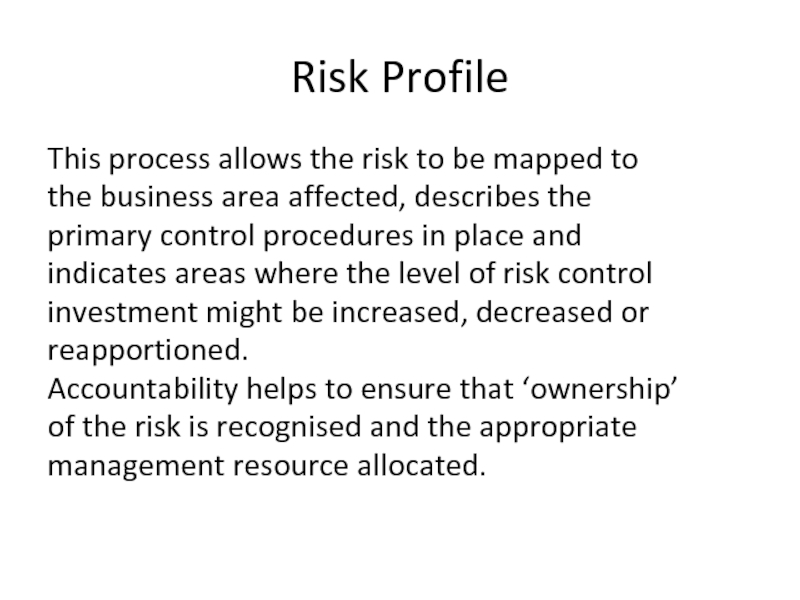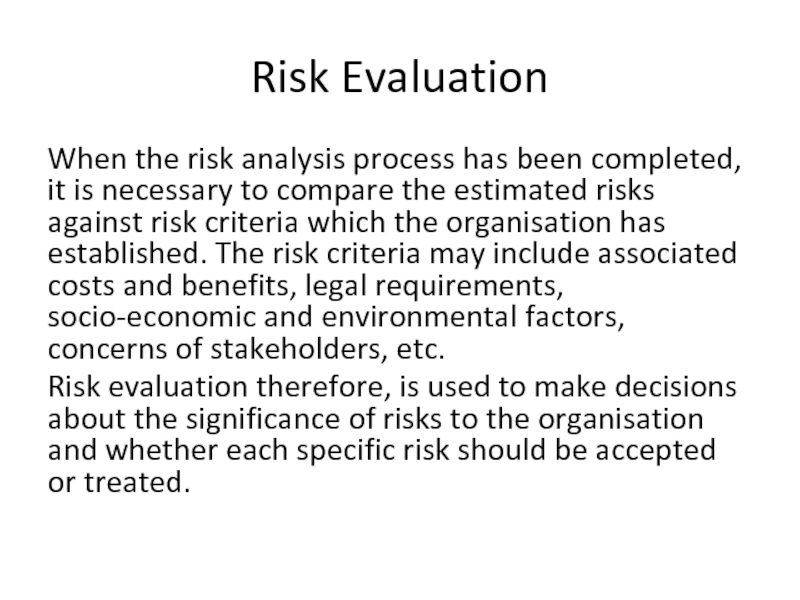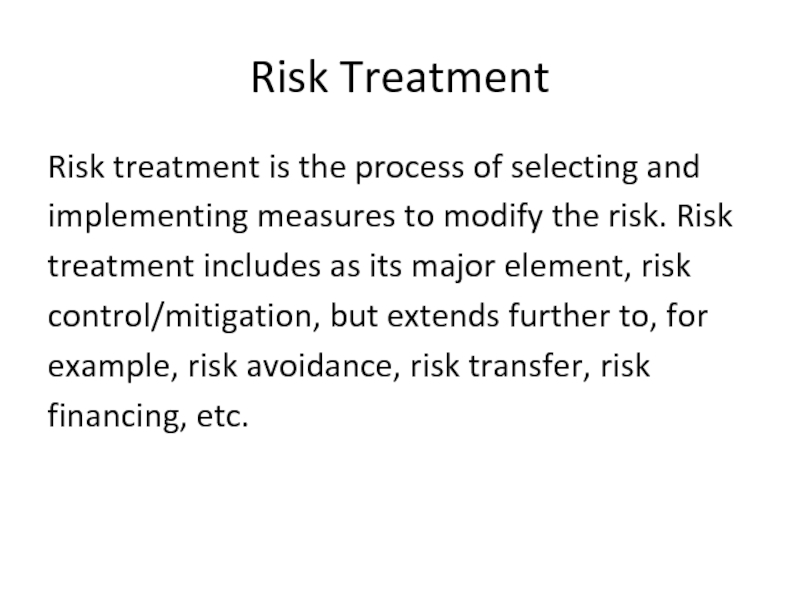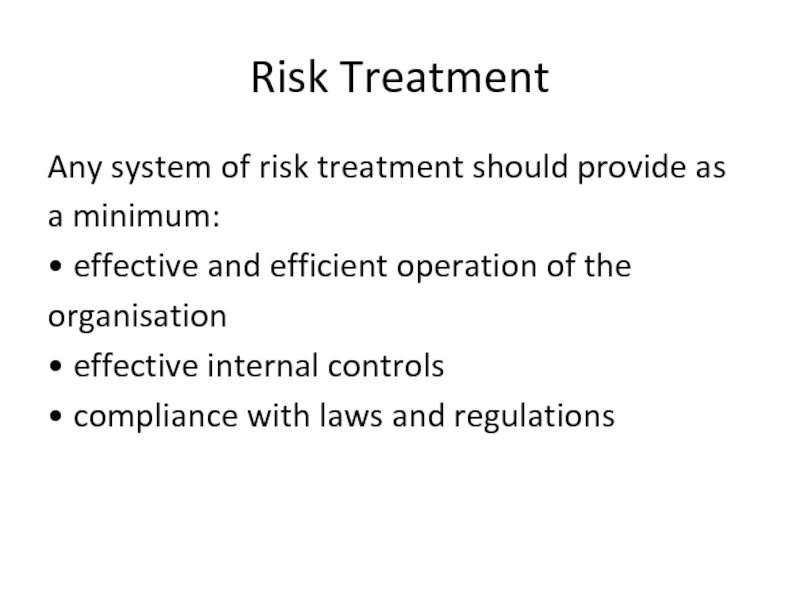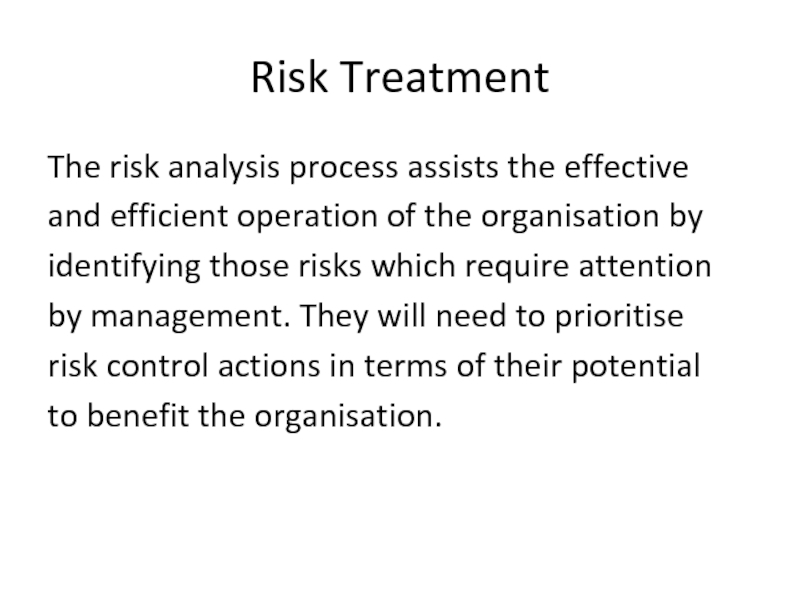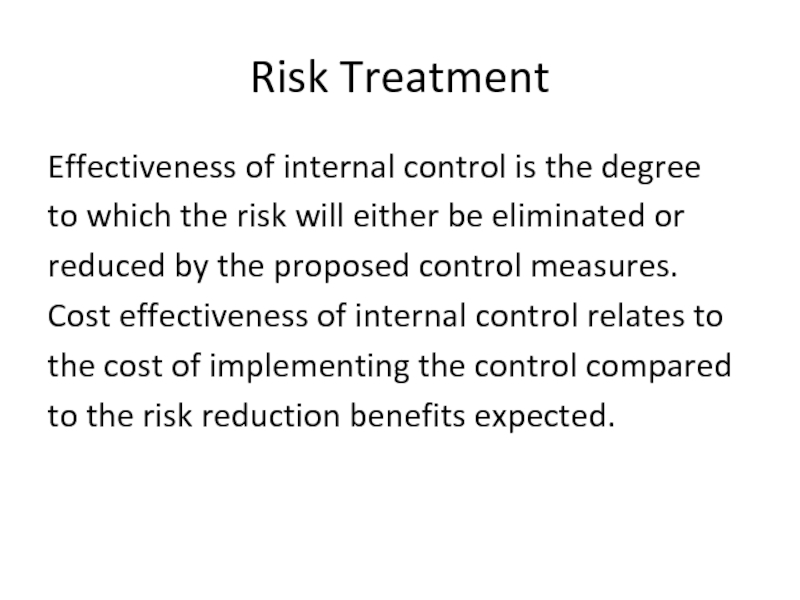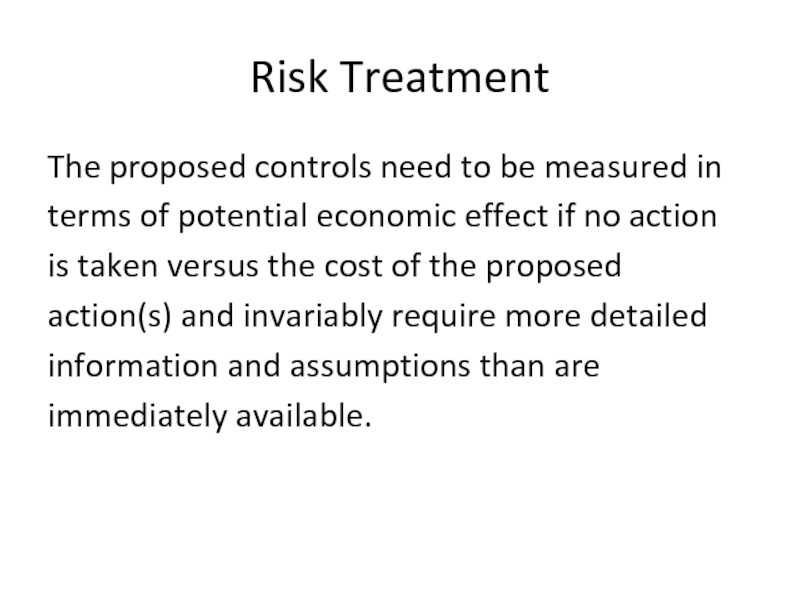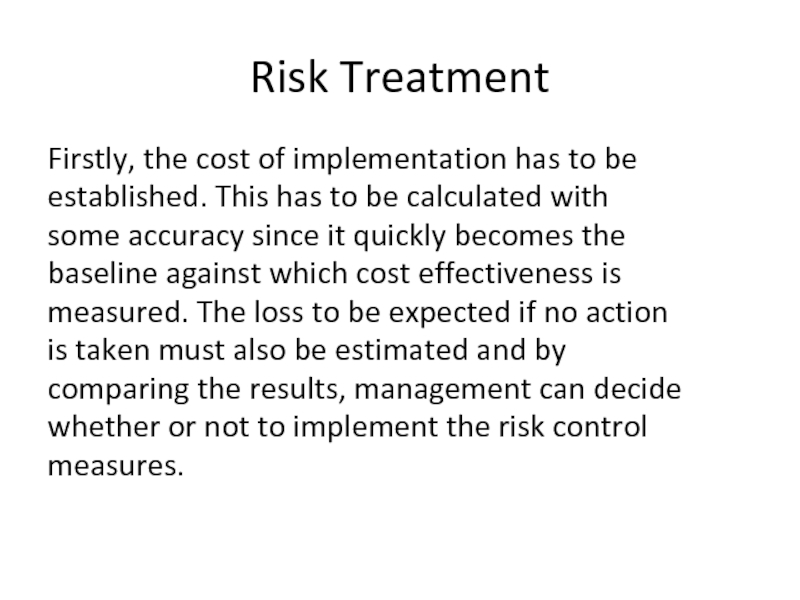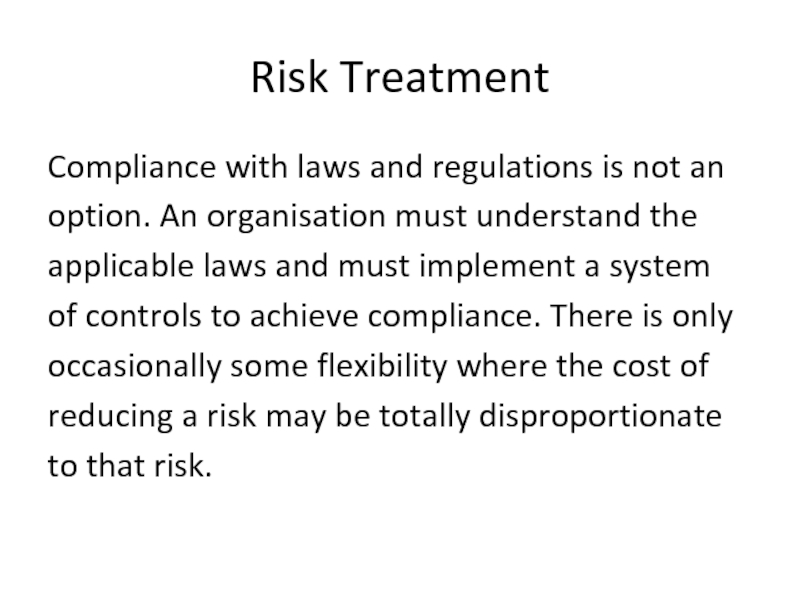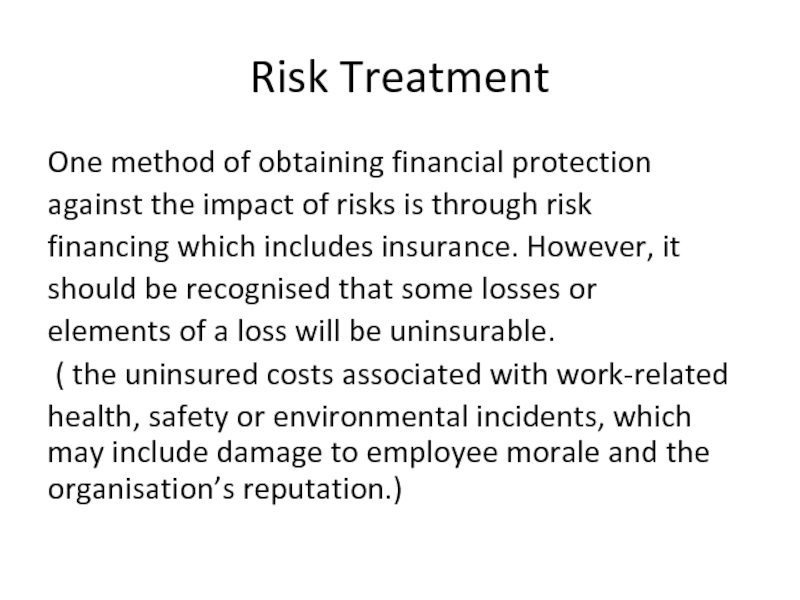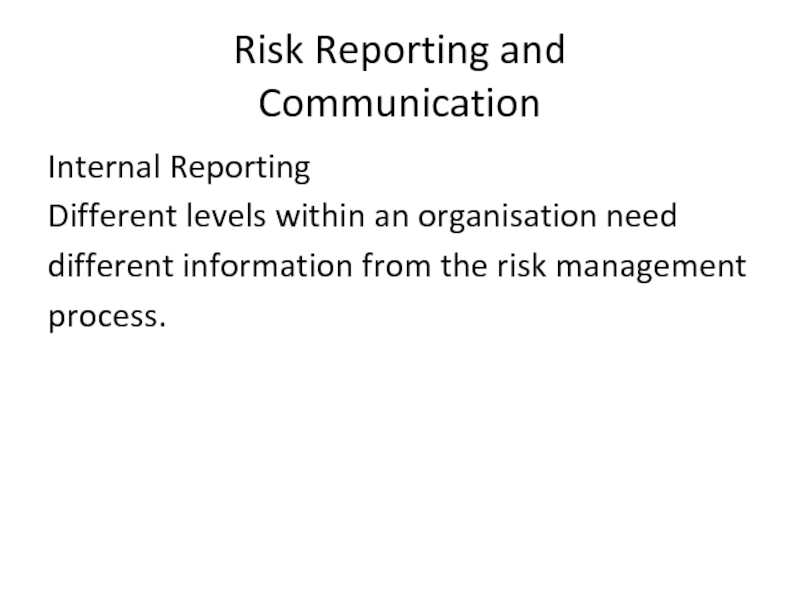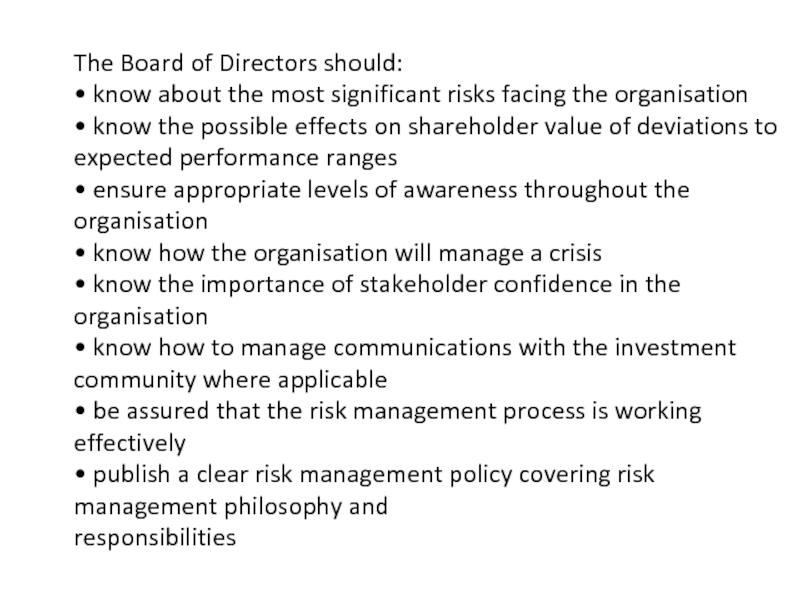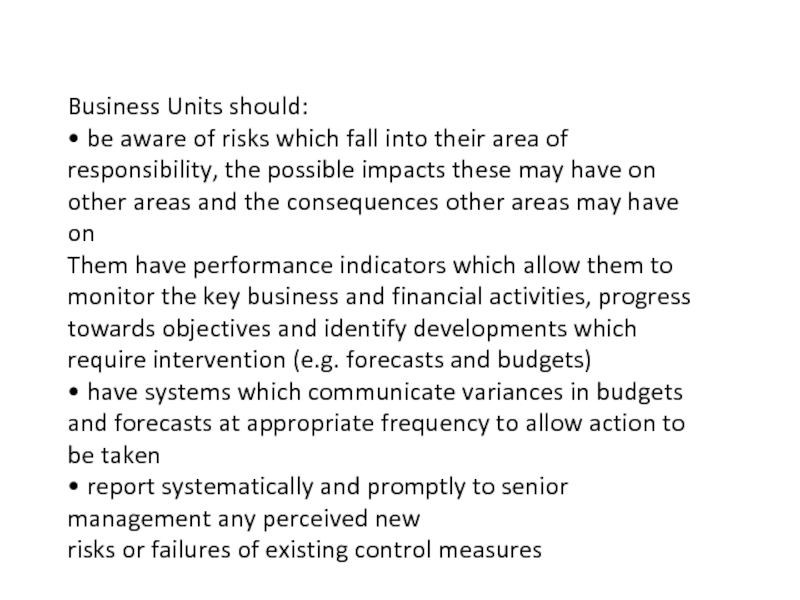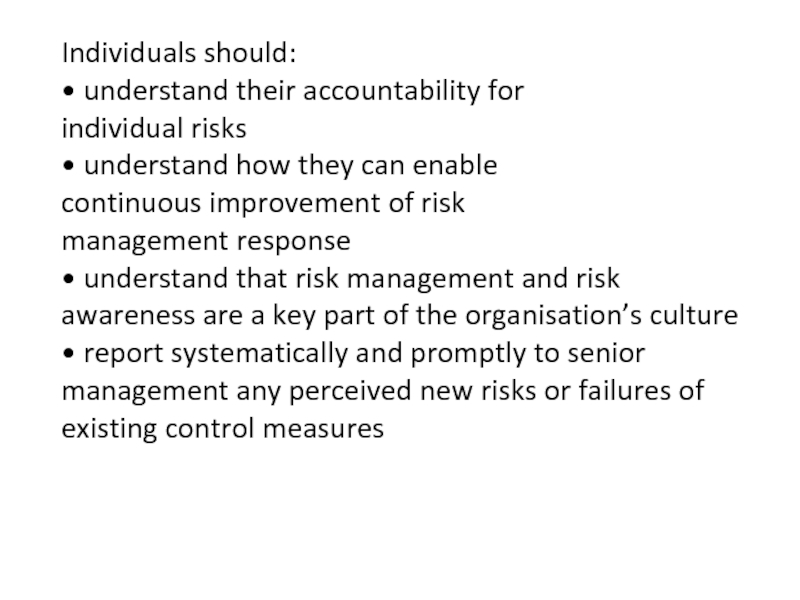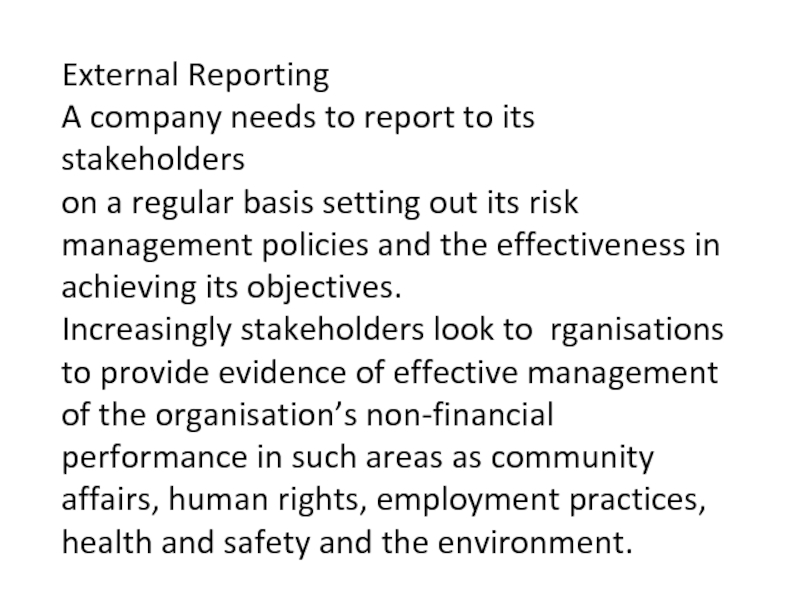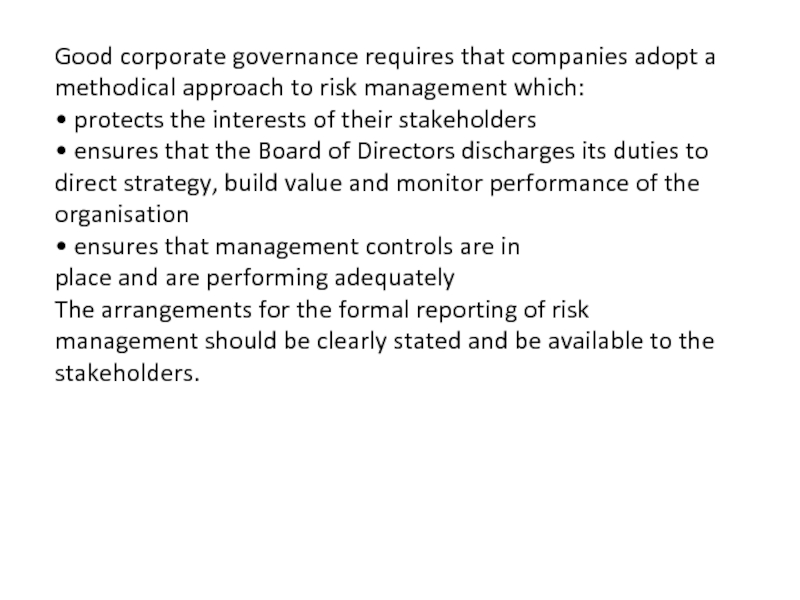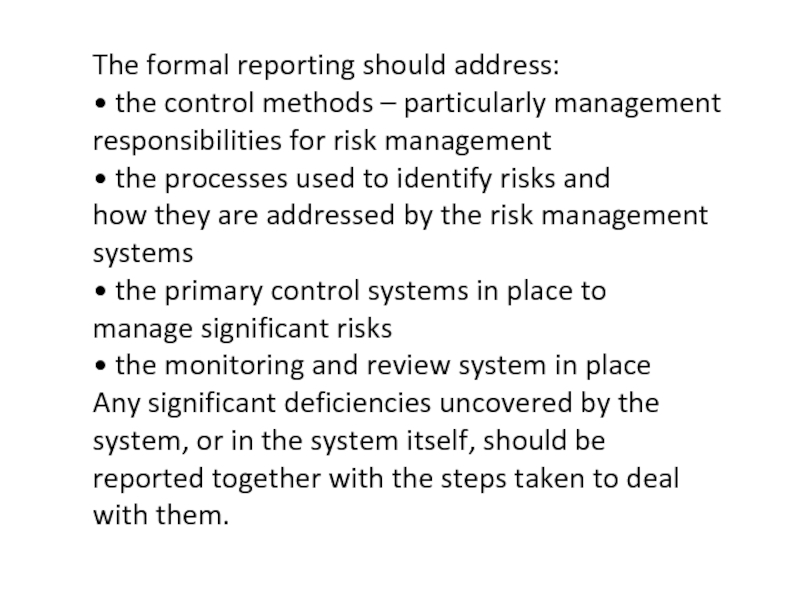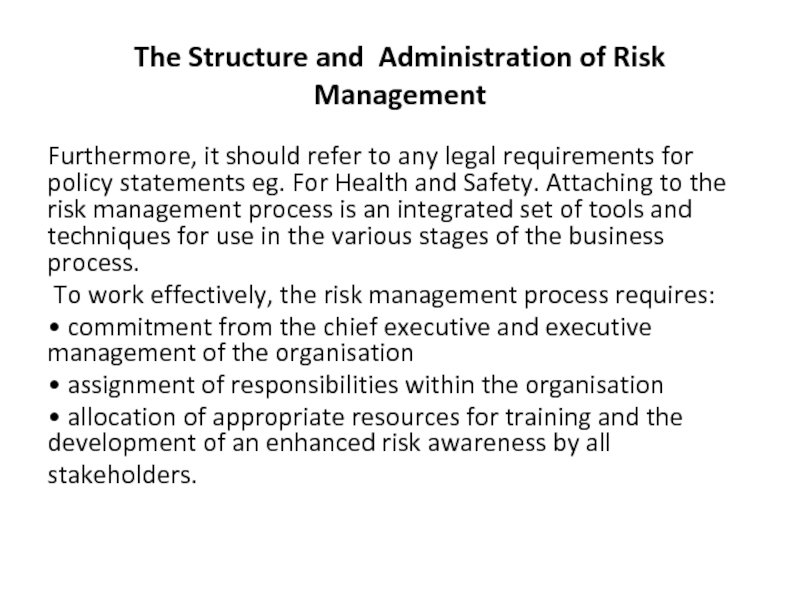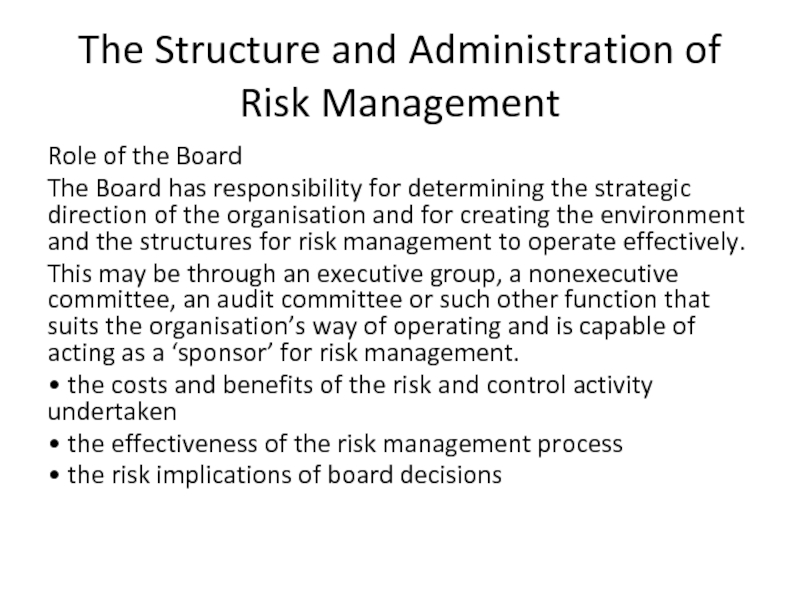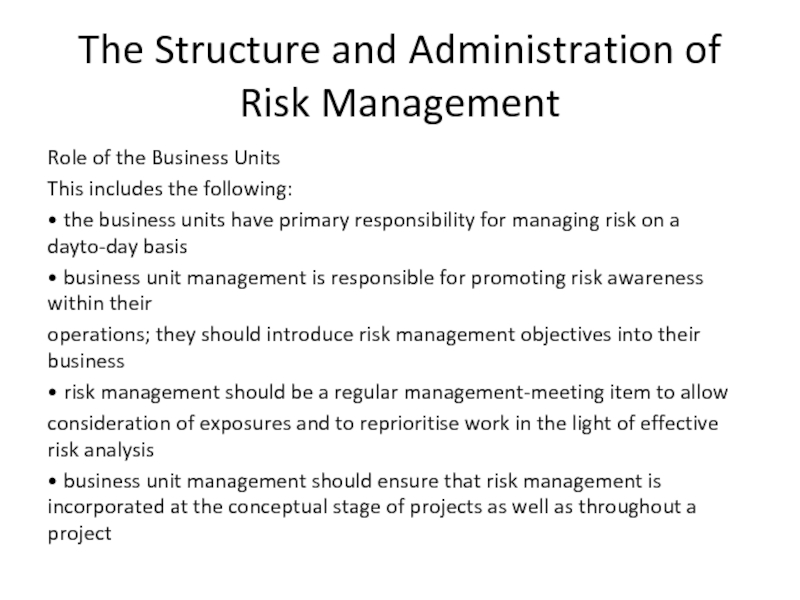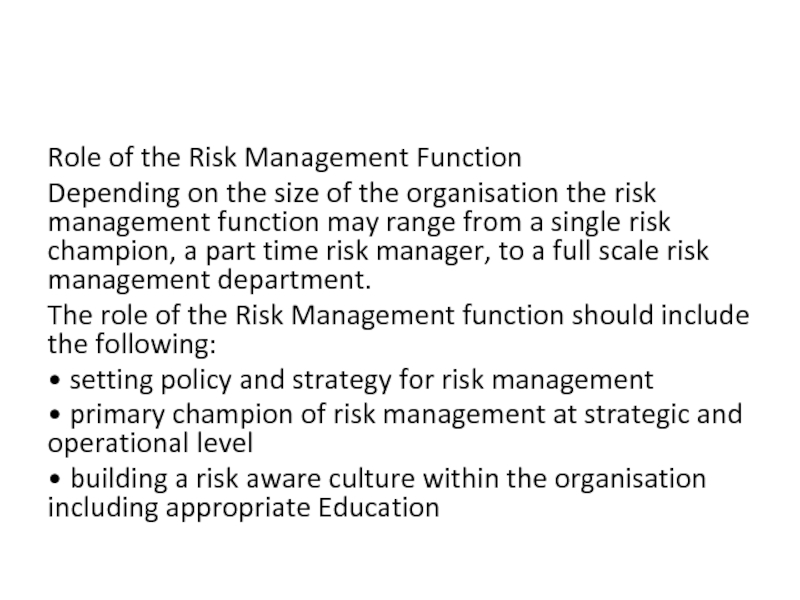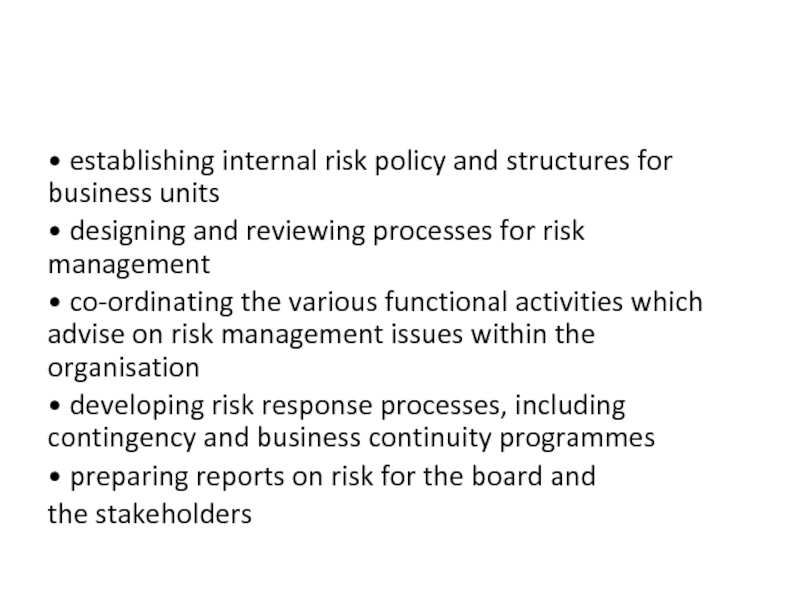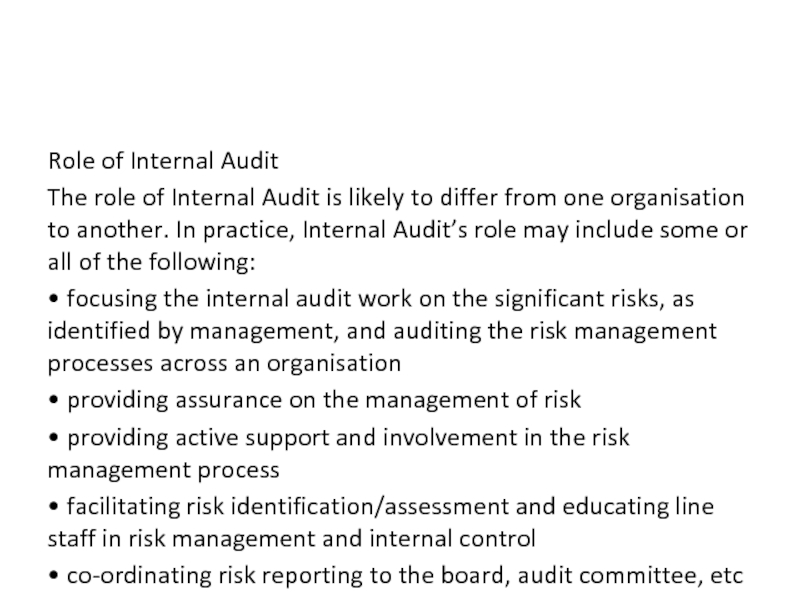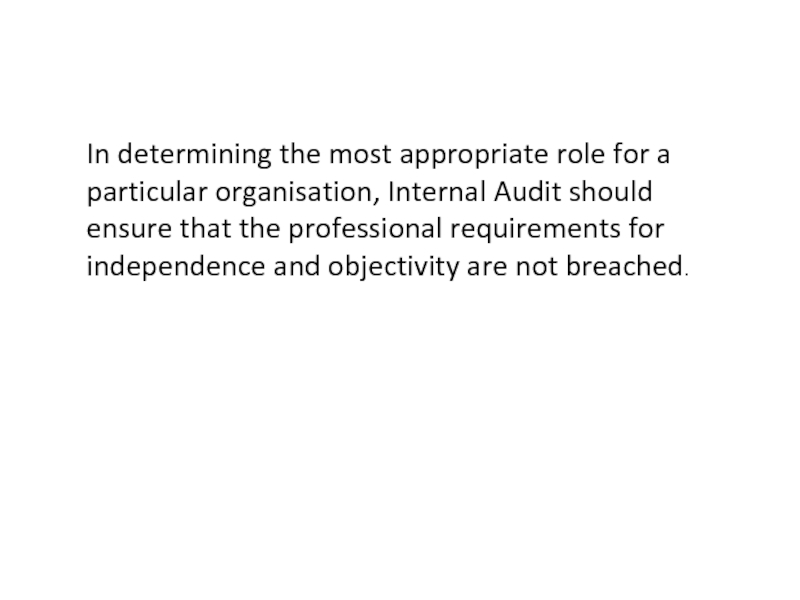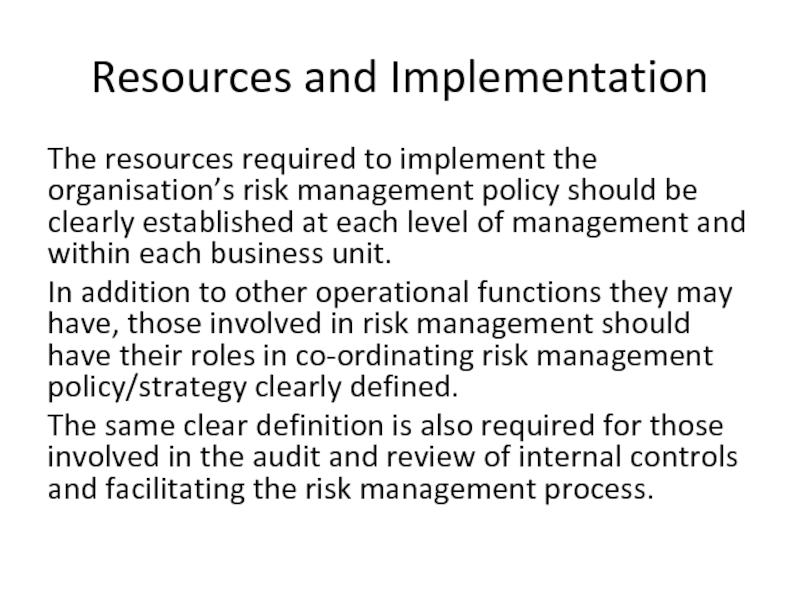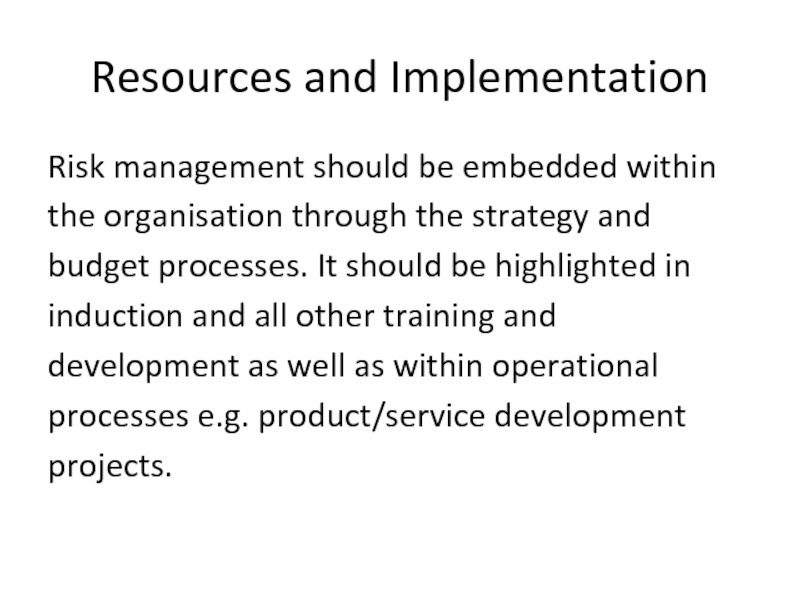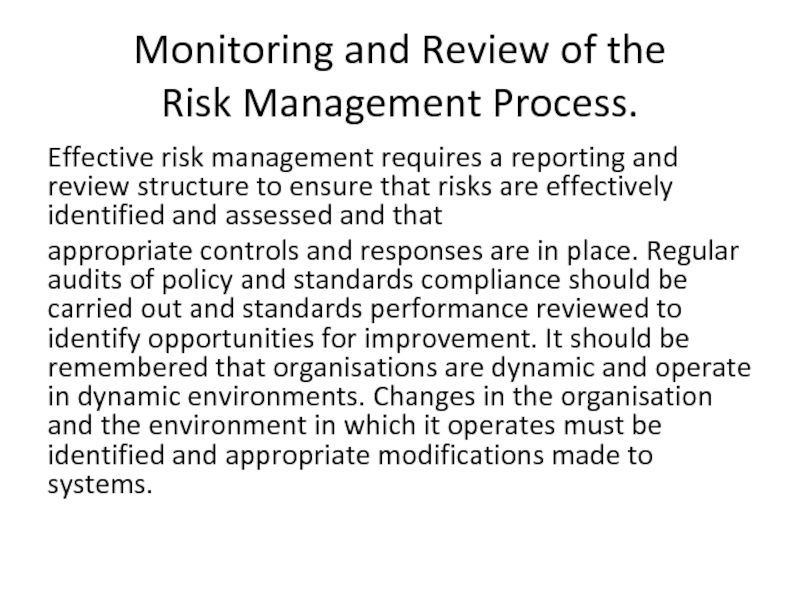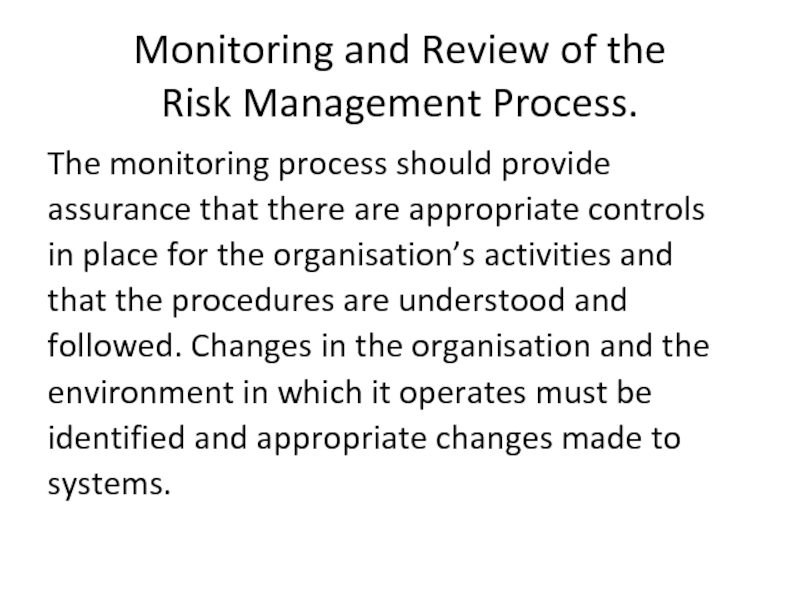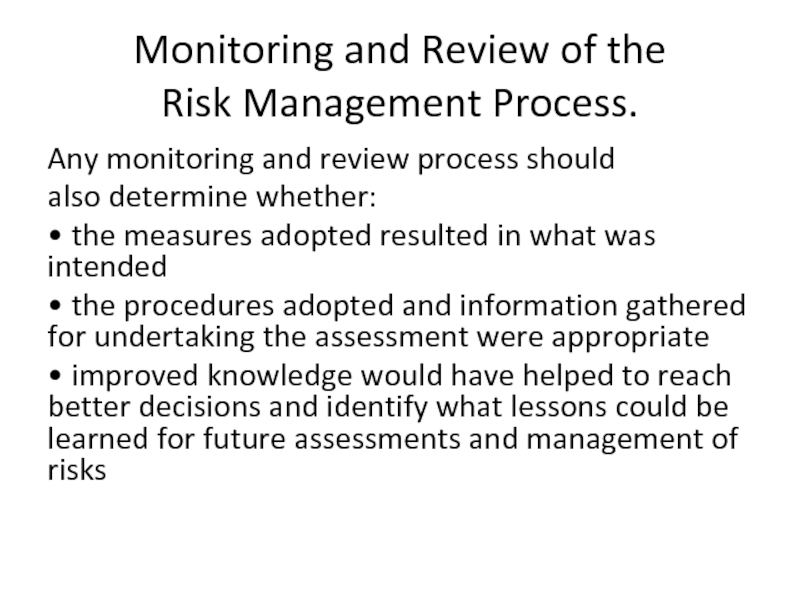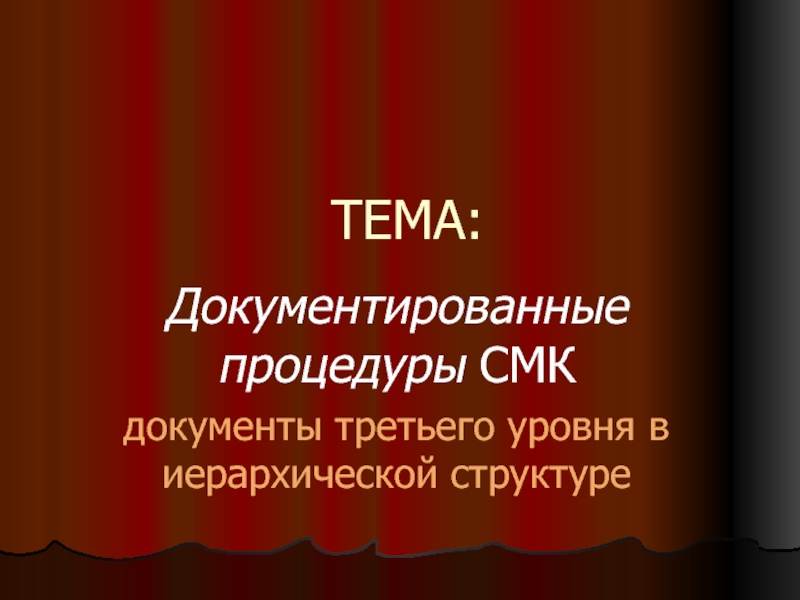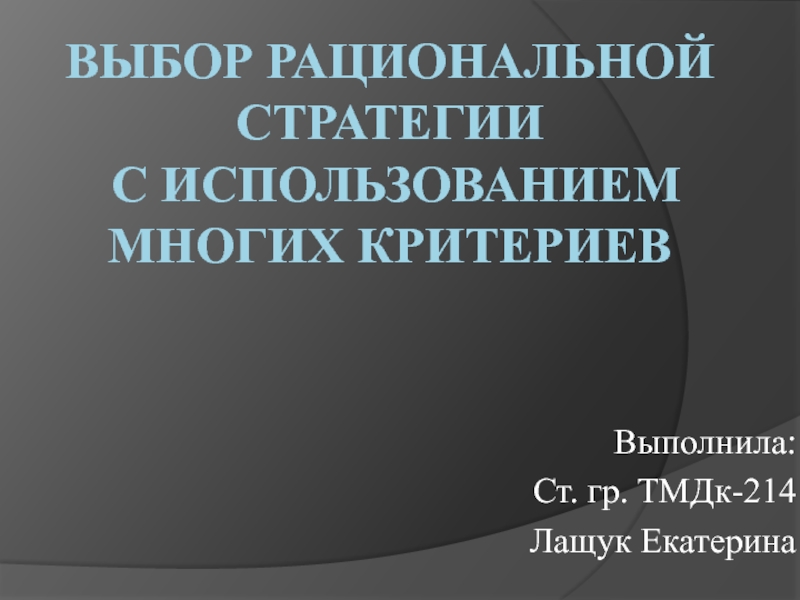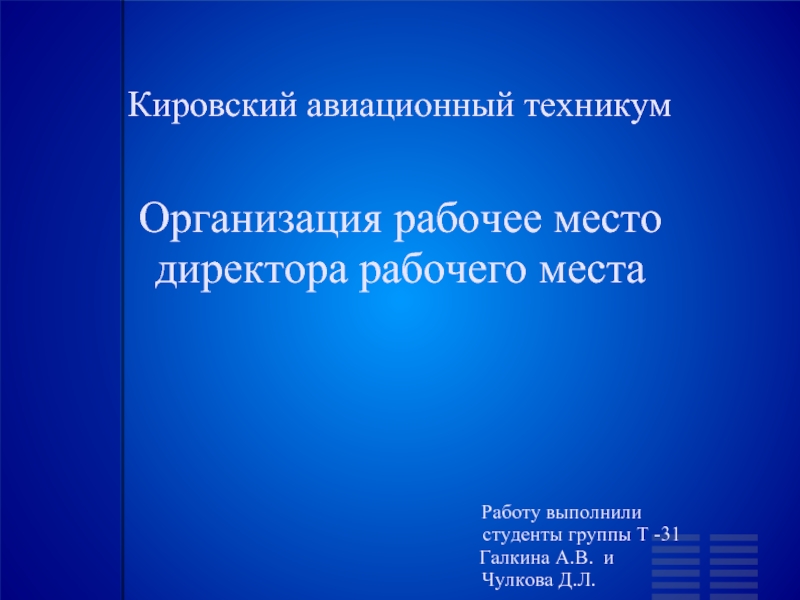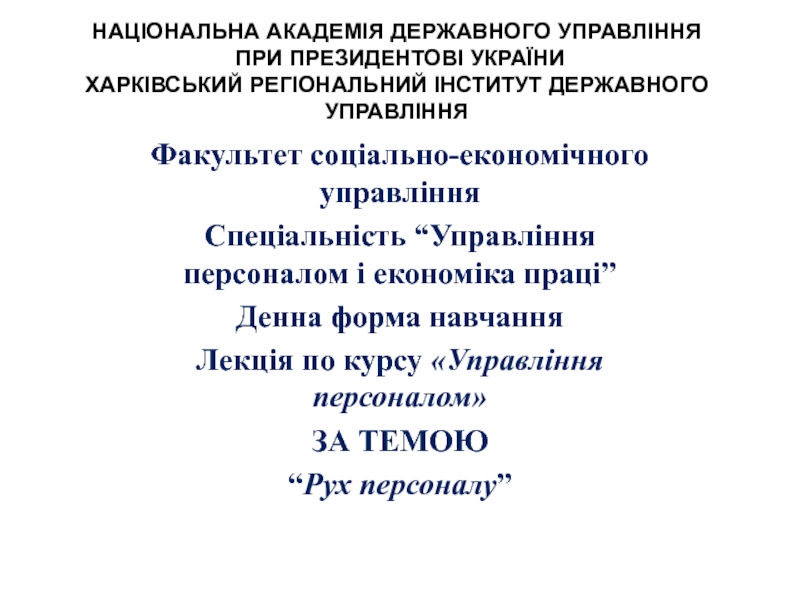Arkhangelsk
23.08.2017
- Главная
- Разное
- Дизайн
- Бизнес и предпринимательство
- Аналитика
- Образование
- Развлечения
- Красота и здоровье
- Финансы
- Государство
- Путешествия
- Спорт
- Недвижимость
- Армия
- Графика
- Культурология
- Еда и кулинария
- Лингвистика
- Английский язык
- Астрономия
- Алгебра
- Биология
- География
- Детские презентации
- Информатика
- История
- Литература
- Маркетинг
- Математика
- Медицина
- Менеджмент
- Музыка
- МХК
- Немецкий язык
- ОБЖ
- Обществознание
- Окружающий мир
- Педагогика
- Русский язык
- Технология
- Физика
- Философия
- Химия
- Шаблоны, картинки для презентаций
- Экология
- Экономика
- Юриспруденция
Risk management approaches презентация
Содержание
- 1. Risk management approaches
- 2. Risk Risk can be defined as the
- 3. Risk Management Risk Management is increasingly recognised
- 4. Risk Management Risk management is a central
- 5. Risk Management The focus of good risk
- 6. Risk Management It increases the probability of
- 7. Risk Management It must be integrated into
- 8. External and Internal Factors The risks facing
- 9. External and Internal Factors
- 10. The Risk Management Process Risk management protects
- 11. The Risk Management Process
- 12. Risk Assessment Risk Assessment is defined by
- 13. Risk Analysis Risk identification sets out to
- 14. Risk identification should be approached in
- 15. All associated volatility related to these
- 16. Knowledge management - These concern the
- 17. Compliance - These concern such issues
- 18. Whilst risk identification can be carried
- 19. Risk Description The objective of risk description
- 20. Risk Description By considering the consequence and
- 21. Risk Description
- 22. Risk Estimation Monitoring Risk estimation can be
- 23. Consequences - Both Threats and Opportunities
- 24. Probability of Occurrence - Threats
- 25. Probability of Occurrence - Opportunities
- 26. Risk Analysis methods and techniques A range
- 27. Risk Analysis methods and techniques Risk Identification
- 28. Risk Analysis methods and techniques Both •
- 29. Risk Analysis methods and techniques Downside risk
- 30. Risk Profile The result of the risk
- 31. Risk Profile This process allows the risk
- 32. Risk Evaluation When the risk analysis process
- 33. Risk Treatment Risk treatment is the process
- 34. Risk Treatment Any system of risk treatment
- 35. Risk Treatment The risk analysis process assists
- 36. Risk Treatment Effectiveness of internal control is
- 37. Risk Treatment The proposed controls need to
- 38. Risk Treatment Firstly, the cost of implementation
- 39. Risk Treatment Compliance with laws and regulations
- 40. Risk Treatment One method of obtaining financial
- 41. Risk Reporting and Communication Internal Reporting Different
- 42. The Board of Directors should: • know
- 43. Business Units should: • be aware of
- 44. Individuals should: • understand their accountability for
- 45. External Reporting A company needs to report
- 46. Good corporate governance requires that companies adopt
- 47. The formal reporting should address: • the
- 48. The Structure and Administration of Risk Management
- 49. The Structure and Administration of Risk Management
- 50. The Structure and Administration of Risk Management
- 51. Role of the Risk Management Function
- 52. • establishing internal risk policy and
- 53. Role of Internal Audit The role
- 54. In determining the most appropriate role for
- 55. Resources and Implementation The resources required to
- 56. Resources and Implementation Risk management should be
- 57. Monitoring and Review of the Risk Management
- 58. Monitoring and Review of the Risk Management
- 59. Monitoring and Review of the Risk Management
- 60. THANK YOU FOR ATTENTION
Слайд 2Risk
Risk can be defined as the combination of the
probability of an
event and its consequences
In all types of undertaking, there is the
potential for events and consequences that
constitute opportunities for benefit (upside) or
threats to success (downside).
In all types of undertaking, there is the
potential for events and consequences that
constitute opportunities for benefit (upside) or
threats to success (downside).
Слайд 3Risk Management
Risk Management is increasingly recognised as
being concerned with both positive
and
negative aspects of risk. In the safety field, it is generally recognised that consequences are only negative and therefore the management of safety risk is focused on prevention and mitigation of harm.
negative aspects of risk. In the safety field, it is generally recognised that consequences are only negative and therefore the management of safety risk is focused on prevention and mitigation of harm.
Слайд 4Risk Management
Risk management is a central part of any
organisation’s strategic management.
It is the
process whereby organisations methodically
address the risks attaching to their activities
with the goal of achieving sustained benefit
within each activity and across the portfolio of
all activities.
process whereby organisations methodically
address the risks attaching to their activities
with the goal of achieving sustained benefit
within each activity and across the portfolio of
all activities.
Слайд 5Risk Management
The focus of good risk management is the
identification and treatment
of these risks.
Its objective is to add maximum sustainable
value to all the activities of the organisation. It
marshals the understanding of the potential
upside and downside of all those factors which can affect the organisation.
Its objective is to add maximum sustainable
value to all the activities of the organisation. It
marshals the understanding of the potential
upside and downside of all those factors which can affect the organisation.
Слайд 6Risk Management
It increases the probability of success, and reduces both the
probability of failure and the uncertainty of achieving the organisation’s overall objectives.
Risk management should be a continuous and
developing process which runs throughout the
organisation’s strategy and the implementation
of that strategy. It should address methodically
all the risks surrounding the organisation’s
activities past, present and in particular, future.
Risk management should be a continuous and
developing process which runs throughout the
organisation’s strategy and the implementation
of that strategy. It should address methodically
all the risks surrounding the organisation’s
activities past, present and in particular, future.
Слайд 7Risk Management
It must be integrated into the culture of the organisation
with an effective policy and a programme led by the most senior management. It must translate the strategy into tactical and operational objectives, assigning responsibility throughout the organisation with each manager and employee responsible for the management of risk as part of their job description. It supports
accountability, performance measurement and
reward, thus promoting operational efficiency
at all levels.
accountability, performance measurement and
reward, thus promoting operational efficiency
at all levels.
Слайд 8External and Internal Factors
The risks facing an organisation and its operations
can result from factors both external and internal to the organisation. The diagram overleaf summarises examples of key risks in these areas and shows that some specific risks can have both external and internal drivers and therefore overlap the two areas. They can be categorised further into types of risk such as strategic, financial, operational, hazard, etc.
Слайд 10The Risk Management Process
Risk management protects and adds value to the
organisation and its stakeholders through supporting the organisation’s objectives by:
• providing a framework for an organisation that enables future activity to take place in a consistent and controlled manner
• improving decision making, planning and prioritisation by comprehensive and structured understanding of business activity, volatility and project opportunity/threa
• contributing to more efficient use/allocation of capital and resources within the organisation
• reducing volatility in the non essential areas of the business
• protecting and enhancing assets and company image
• developing and supporting people and the organisation’s knowledge base
• optimising operational efficiency
• providing a framework for an organisation that enables future activity to take place in a consistent and controlled manner
• improving decision making, planning and prioritisation by comprehensive and structured understanding of business activity, volatility and project opportunity/threa
• contributing to more efficient use/allocation of capital and resources within the organisation
• reducing volatility in the non essential areas of the business
• protecting and enhancing assets and company image
• developing and supporting people and the organisation’s knowledge base
• optimising operational efficiency
Слайд 12Risk Assessment
Risk Assessment is defined by the ISO/ IEC
Guide 73 as
the overall process of risk analysis
and risk evaluation.
and risk evaluation.
Слайд 13Risk Analysis
Risk identification sets out to identify an organisation’s exposure to
uncertainty. This requires an intimate knowledge of the organisation, the market in which it operates, the legal, social, political and cultural environment in which it exists, as well as the development of a sound understanding of its strategic and operational objectives, including factors critical to its success and the threats and opportunities related to the achievement of these objectives.
Слайд 14
Risk identification should be approached in a
methodical way to ensure that
all significant
activities within the organisation have been
identified and all the risks flowing from these
activities defined.
activities within the organisation have been
identified and all the risks flowing from these
activities defined.
Слайд 15
All associated volatility related to these
activities should be identified and categorised.
•
Financial - These concern the effective
management and control of the finances of
the organisation and the effects of external
factors such as availability of credit, foreign
exchange rates, interest rate movement and
other market exposures.
management and control of the finances of
the organisation and the effects of external
factors such as availability of credit, foreign
exchange rates, interest rate movement and
other market exposures.
Слайд 16
Knowledge management - These concern the effective management and control of
the knowledge resources, the production, protection and communication thereof.
External factors might include the unauthorised use or abuse of intellectual property, area power failures, and competitive technology. Internal factors might be system malfunction or loss of key
staff
External factors might include the unauthorised use or abuse of intellectual property, area power failures, and competitive technology. Internal factors might be system malfunction or loss of key
staff
Слайд 17
Compliance - These concern such issues as
health & safety, environmental, trade
descriptions,
consumer protection, data
protection, employment practices and
regulatory issues.
protection, employment practices and
regulatory issues.
Слайд 18
Whilst risk identification can be carried out by
outside consultants, an in-house
approach with
well communicated, consistent and coordinated
processes and tools is likely to be more effective. In-house ‘ownership’ of the risk management process is essential.
well communicated, consistent and coordinated
processes and tools is likely to be more effective. In-house ‘ownership’ of the risk management process is essential.
Слайд 19Risk Description
The objective of risk description is to display
the identified risks
in a structured format, for
example, by using a table. The risk description
table overleaf can be used to facilitate the
description and assessment of risks. The use of
a well designed structure is necessary to
ensure a comprehensive risk identification,
description and assessment process.
example, by using a table. The risk description
table overleaf can be used to facilitate the
description and assessment of risks. The use of
a well designed structure is necessary to
ensure a comprehensive risk identification,
description and assessment process.
Слайд 20Risk Description
By considering the consequence and probability of
each of the risks
set out in the table, it should be possible to prioritise the key risks that need to be analysed in more detail. Identification of the risks associated with business activities and decision making may be categorised as strategic, project/ tactical, operational. It is important to incorporate risk management at the conceptual stage of projects as well as throughout the life of a specific project.
Слайд 22Risk Estimation Monitoring
Risk estimation can be quantitative, semiquantitative or qualitative in
terms of the
probability of occurrence and the possible
consequence. For example, consequences both in terms of threats (downside risks) and opportunities
(upside risks) may be high, medium or low. Probability may be high, medium or low but requires different definitions in respect of threats and opportunities
probability of occurrence and the possible
consequence. For example, consequences both in terms of threats (downside risks) and opportunities
(upside risks) may be high, medium or low. Probability may be high, medium or low but requires different definitions in respect of threats and opportunities
Слайд 26Risk Analysis methods and techniques
A range of techniques can be used
to analyse
risks. These can be specific to upside or
downside risk or be capable of dealing with
both.
risks. These can be specific to upside or
downside risk or be capable of dealing with
both.
Слайд 27Risk Analysis methods and techniques
Risk Identification Techniques - examples
• Brainstorming
• Questionnaires
•
Business studies which look at each business process and describe both the internal processes and external factors
which can influence those processes
• Industry benchmarking
• Scenario analysis
• Risk assessment workshops
• Incident investigation
• Auditing and inspection
• HAZOP (Hazard & Operability Studies)
which can influence those processes
• Industry benchmarking
• Scenario analysis
• Risk assessment workshops
• Incident investigation
• Auditing and inspection
• HAZOP (Hazard & Operability Studies)
Слайд 28Risk Analysis methods and techniques
Both
• Dependency modelling
• SWOT analysis (Strengths, Weaknesses,
Opportunities, Threats)
• Event tree analysis
• Business continuity planning
• BPEST (Business, Political, Economic, Social, Technological) analysis
• Real Option Modelling
• Decision taking under conditions of risk and uncertainty
• Statistical inference
• Measures of central tendency and dispersion
• PESTLE (Political Economic Social Technical Legal Environmental)
• Event tree analysis
• Business continuity planning
• BPEST (Business, Political, Economic, Social, Technological) analysis
• Real Option Modelling
• Decision taking under conditions of risk and uncertainty
• Statistical inference
• Measures of central tendency and dispersion
• PESTLE (Political Economic Social Technical Legal Environmental)
Слайд 29Risk Analysis methods and techniques
Downside risk
• Threat analysis
• Fault tree analysis
•
FMEA (Failure Mode & Effect Analysis)
Слайд 30Risk Profile
The result of the risk analysis process can be
used to
produce a risk profile which gives a
significance rating to each risk and provides a
tool for prioritising risk treatment efforts. This
ranks each identified risk so as to give a view
of the relative importance.
significance rating to each risk and provides a
tool for prioritising risk treatment efforts. This
ranks each identified risk so as to give a view
of the relative importance.
Слайд 31Risk Profile
This process allows the risk to be mapped to
the business
area affected, describes the
primary control procedures in place and
indicates areas where the level of risk control
investment might be increased, decreased or
reapportioned.
Accountability helps to ensure that ‘ownership’
of the risk is recognised and the appropriate
management resource allocated.
primary control procedures in place and
indicates areas where the level of risk control
investment might be increased, decreased or
reapportioned.
Accountability helps to ensure that ‘ownership’
of the risk is recognised and the appropriate
management resource allocated.
Слайд 32Risk Evaluation
When the risk analysis process has been completed, it is
necessary to compare the estimated risks against risk criteria which the organisation has established. The risk criteria may include associated costs and benefits, legal requirements, socio-economic and environmental factors, concerns of stakeholders, etc.
Risk evaluation therefore, is used to make decisions about the significance of risks to the organisation and whether each specific risk should be accepted or treated.
Risk evaluation therefore, is used to make decisions about the significance of risks to the organisation and whether each specific risk should be accepted or treated.
Слайд 33Risk Treatment
Risk treatment is the process of selecting and
implementing measures to
modify the risk. Risk
treatment includes as its major element, risk
control/mitigation, but extends further to, for
example, risk avoidance, risk transfer, risk
financing, etc.
treatment includes as its major element, risk
control/mitigation, but extends further to, for
example, risk avoidance, risk transfer, risk
financing, etc.
Слайд 34Risk Treatment
Any system of risk treatment should provide as
a minimum:
• effective
and efficient operation of the
organisation
• effective internal controls
• compliance with laws and regulations
organisation
• effective internal controls
• compliance with laws and regulations
Слайд 35Risk Treatment
The risk analysis process assists the effective
and efficient operation of
the organisation by
identifying those risks which require attention
by management. They will need to prioritise
risk control actions in terms of their potential
to benefit the organisation.
identifying those risks which require attention
by management. They will need to prioritise
risk control actions in terms of their potential
to benefit the organisation.
Слайд 36Risk Treatment
Effectiveness of internal control is the degree
to which the risk
will either be eliminated or
reduced by the proposed control measures.
Cost effectiveness of internal control relates to
the cost of implementing the control compared
to the risk reduction benefits expected.
reduced by the proposed control measures.
Cost effectiveness of internal control relates to
the cost of implementing the control compared
to the risk reduction benefits expected.
Слайд 37Risk Treatment
The proposed controls need to be measured in
terms of potential
economic effect if no action
is taken versus the cost of the proposed
action(s) and invariably require more detailed
information and assumptions than are
immediately available.
is taken versus the cost of the proposed
action(s) and invariably require more detailed
information and assumptions than are
immediately available.
Слайд 38Risk Treatment
Firstly, the cost of implementation has to be
established. This has
to be calculated with
some accuracy since it quickly becomes the
baseline against which cost effectiveness is
measured. The loss to be expected if no action
is taken must also be estimated and by
comparing the results, management can decide
whether or not to implement the risk control
measures.
some accuracy since it quickly becomes the
baseline against which cost effectiveness is
measured. The loss to be expected if no action
is taken must also be estimated and by
comparing the results, management can decide
whether or not to implement the risk control
measures.
Слайд 39Risk Treatment
Compliance with laws and regulations is not an
option. An organisation
must understand the
applicable laws and must implement a system
of controls to achieve compliance. There is only
occasionally some flexibility where the cost of
reducing a risk may be totally disproportionate
to that risk.
applicable laws and must implement a system
of controls to achieve compliance. There is only
occasionally some flexibility where the cost of
reducing a risk may be totally disproportionate
to that risk.
Слайд 40Risk Treatment
One method of obtaining financial protection
against the impact of risks
is through risk
financing which includes insurance. However, it
should be recognised that some losses or
elements of a loss will be uninsurable.
( the uninsured costs associated with work-related
health, safety or environmental incidents, which may include damage to employee morale and the organisation’s reputation.)
financing which includes insurance. However, it
should be recognised that some losses or
elements of a loss will be uninsurable.
( the uninsured costs associated with work-related
health, safety or environmental incidents, which may include damage to employee morale and the organisation’s reputation.)
Слайд 41Risk Reporting and
Communication
Internal Reporting
Different levels within an organisation need
different information from
the risk management
process.
process.
Слайд 42The Board of Directors should:
• know about the most significant risks
facing the organisation
• know the possible effects on shareholder value of deviations to expected performance ranges
• ensure appropriate levels of awareness throughout the organisation
• know how the organisation will manage a crisis
• know the importance of stakeholder confidence in the organisation
• know how to manage communications with the investment community where applicable
• be assured that the risk management process is working effectively
• publish a clear risk management policy covering risk management philosophy and
responsibilities
• know the possible effects on shareholder value of deviations to expected performance ranges
• ensure appropriate levels of awareness throughout the organisation
• know how the organisation will manage a crisis
• know the importance of stakeholder confidence in the organisation
• know how to manage communications with the investment community where applicable
• be assured that the risk management process is working effectively
• publish a clear risk management policy covering risk management philosophy and
responsibilities
Слайд 43Business Units should:
• be aware of risks which fall into their
area of responsibility, the possible impacts these may have on other areas and the consequences other areas may have on
Them have performance indicators which allow them to monitor the key business and financial activities, progress towards objectives and identify developments which require intervention (e.g. forecasts and budgets)
• have systems which communicate variances in budgets and forecasts at appropriate frequency to allow action to be taken
• report systematically and promptly to senior management any perceived new
risks or failures of existing control measures
Them have performance indicators which allow them to monitor the key business and financial activities, progress towards objectives and identify developments which require intervention (e.g. forecasts and budgets)
• have systems which communicate variances in budgets and forecasts at appropriate frequency to allow action to be taken
• report systematically and promptly to senior management any perceived new
risks or failures of existing control measures
Слайд 44Individuals should:
• understand their accountability for
individual risks
• understand how they can
enable
continuous improvement of risk
management response
• understand that risk management and risk
awareness are a key part of the organisation’s culture
• report systematically and promptly to senior management any perceived new risks or failures of existing control measures
continuous improvement of risk
management response
• understand that risk management and risk
awareness are a key part of the organisation’s culture
• report systematically and promptly to senior management any perceived new risks or failures of existing control measures
Слайд 45External Reporting
A company needs to report to its stakeholders
on a regular
basis setting out its risk
management policies and the effectiveness in
achieving its objectives.
Increasingly stakeholders look to rganisations
to provide evidence of effective management of the organisation’s non-financial performance in such areas as community affairs, human rights, employment practices, health and safety and the environment.
management policies and the effectiveness in
achieving its objectives.
Increasingly stakeholders look to rganisations
to provide evidence of effective management of the organisation’s non-financial performance in such areas as community affairs, human rights, employment practices, health and safety and the environment.
Слайд 46Good corporate governance requires that companies adopt a methodical approach to
risk management which:
• protects the interests of their stakeholders
• ensures that the Board of Directors discharges its duties to direct strategy, build value and monitor performance of the
organisation
• ensures that management controls are in
place and are performing adequately
The arrangements for the formal reporting of risk management should be clearly stated and be available to the stakeholders.
• protects the interests of their stakeholders
• ensures that the Board of Directors discharges its duties to direct strategy, build value and monitor performance of the
organisation
• ensures that management controls are in
place and are performing adequately
The arrangements for the formal reporting of risk management should be clearly stated and be available to the stakeholders.
Слайд 47The formal reporting should address:
• the control methods – particularly management
responsibilities for risk management
• the processes used to identify risks and
how they are addressed by the risk management systems
• the primary control systems in place to
manage significant risks
• the monitoring and review system in place
Any significant deficiencies uncovered by the
system, or in the system itself, should be
reported together with the steps taken to deal
with them.
• the processes used to identify risks and
how they are addressed by the risk management systems
• the primary control systems in place to
manage significant risks
• the monitoring and review system in place
Any significant deficiencies uncovered by the
system, or in the system itself, should be
reported together with the steps taken to deal
with them.
Слайд 48The Structure and Administration of Risk
Management
Furthermore, it should refer to any
legal requirements for policy statements eg. For Health and Safety. Attaching to the risk management process is an integrated set of tools and techniques for use in the various stages of the business process.
To work effectively, the risk management process requires:
• commitment from the chief executive and executive management of the organisation
• assignment of responsibilities within the organisation
• allocation of appropriate resources for training and the development of an enhanced risk awareness by all
stakeholders.
To work effectively, the risk management process requires:
• commitment from the chief executive and executive management of the organisation
• assignment of responsibilities within the organisation
• allocation of appropriate resources for training and the development of an enhanced risk awareness by all
stakeholders.
Слайд 49The Structure and Administration of Risk Management
Role of the Board
The Board
has responsibility for determining the strategic direction of the organisation and for creating the environment and the structures for risk management to operate effectively.
This may be through an executive group, a nonexecutive committee, an audit committee or such other function that suits the organisation’s way of operating and is capable of acting as a ‘sponsor’ for risk management.
• the costs and benefits of the risk and control activity undertaken
• the effectiveness of the risk management process
• the risk implications of board decisions
This may be through an executive group, a nonexecutive committee, an audit committee or such other function that suits the organisation’s way of operating and is capable of acting as a ‘sponsor’ for risk management.
• the costs and benefits of the risk and control activity undertaken
• the effectiveness of the risk management process
• the risk implications of board decisions
Слайд 50The Structure and Administration of Risk Management
Role of the Business Units
This
includes the following:
• the business units have primary responsibility for managing risk on a dayto-day basis
• business unit management is responsible for promoting risk awareness within their
operations; they should introduce risk management objectives into their business
• risk management should be a regular management-meeting item to allow
consideration of exposures and to reprioritise work in the light of effective risk analysis
• business unit management should ensure that risk management is incorporated at the conceptual stage of projects as well as throughout a project
• the business units have primary responsibility for managing risk on a dayto-day basis
• business unit management is responsible for promoting risk awareness within their
operations; they should introduce risk management objectives into their business
• risk management should be a regular management-meeting item to allow
consideration of exposures and to reprioritise work in the light of effective risk analysis
• business unit management should ensure that risk management is incorporated at the conceptual stage of projects as well as throughout a project
Слайд 51
Role of the Risk Management Function
Depending on the size of the
organisation the risk management function may range from a single risk champion, a part time risk manager, to a full scale risk management department.
The role of the Risk Management function should include the following:
• setting policy and strategy for risk management
• primary champion of risk management at strategic and operational level
• building a risk aware culture within the organisation including appropriate Education
The role of the Risk Management function should include the following:
• setting policy and strategy for risk management
• primary champion of risk management at strategic and operational level
• building a risk aware culture within the organisation including appropriate Education
Слайд 52
• establishing internal risk policy and structures for business units
• designing
and reviewing processes for risk management
• co-ordinating the various functional activities which advise on risk management issues within the organisation
• developing risk response processes, including contingency and business continuity programmes
• preparing reports on risk for the board and
the stakeholders
• co-ordinating the various functional activities which advise on risk management issues within the organisation
• developing risk response processes, including contingency and business continuity programmes
• preparing reports on risk for the board and
the stakeholders
Слайд 53
Role of Internal Audit
The role of Internal Audit is likely to
differ from one organisation to another. In practice, Internal Audit’s role may include some or all of the following:
• focusing the internal audit work on the significant risks, as identified by management, and auditing the risk management processes across an organisation
• providing assurance on the management of risk
• providing active support and involvement in the risk management process
• facilitating risk identification/assessment and educating line staff in risk management and internal control
• co-ordinating risk reporting to the board, audit committee, etc
• focusing the internal audit work on the significant risks, as identified by management, and auditing the risk management processes across an organisation
• providing assurance on the management of risk
• providing active support and involvement in the risk management process
• facilitating risk identification/assessment and educating line staff in risk management and internal control
• co-ordinating risk reporting to the board, audit committee, etc
Слайд 54In determining the most appropriate role for a
particular organisation, Internal Audit
should
ensure that the professional requirements for
independence and objectivity are not breached.
ensure that the professional requirements for
independence and objectivity are not breached.
Слайд 55Resources and Implementation
The resources required to implement the organisation’s risk management
policy should be clearly established at each level of management and within each business unit.
In addition to other operational functions they may have, those involved in risk management should have their roles in co-ordinating risk management policy/strategy clearly defined.
The same clear definition is also required for those involved in the audit and review of internal controls and facilitating the risk management process.
In addition to other operational functions they may have, those involved in risk management should have their roles in co-ordinating risk management policy/strategy clearly defined.
The same clear definition is also required for those involved in the audit and review of internal controls and facilitating the risk management process.
Слайд 56Resources and Implementation
Risk management should be embedded within
the organisation through the
strategy and
budget processes. It should be highlighted in
induction and all other training and
development as well as within operational
processes e.g. product/service development
projects.
budget processes. It should be highlighted in
induction and all other training and
development as well as within operational
processes e.g. product/service development
projects.
Слайд 57Monitoring and Review of the
Risk Management Process.
Effective risk management requires a
reporting and review structure to ensure that risks are effectively identified and assessed and that
appropriate controls and responses are in place. Regular audits of policy and standards compliance should be carried out and standards performance reviewed to identify opportunities for improvement. It should be remembered that organisations are dynamic and operate in dynamic environments. Changes in the organisation and the environment in which it operates must be identified and appropriate modifications made to systems.
appropriate controls and responses are in place. Regular audits of policy and standards compliance should be carried out and standards performance reviewed to identify opportunities for improvement. It should be remembered that organisations are dynamic and operate in dynamic environments. Changes in the organisation and the environment in which it operates must be identified and appropriate modifications made to systems.
Слайд 58Monitoring and Review of the
Risk Management Process.
The monitoring process should provide
assurance
that there are appropriate controls
in place for the organisation’s activities and
that the procedures are understood and
followed. Changes in the organisation and the
environment in which it operates must be
identified and appropriate changes made to
systems.
in place for the organisation’s activities and
that the procedures are understood and
followed. Changes in the organisation and the
environment in which it operates must be
identified and appropriate changes made to
systems.
Слайд 59Monitoring and Review of the
Risk Management Process.
Any monitoring and review process
should
also determine whether:
• the measures adopted resulted in what was intended
• the procedures adopted and information gathered for undertaking the assessment were appropriate
• improved knowledge would have helped to reach better decisions and identify what lessons could be learned for future assessments and management of risks
also determine whether:
• the measures adopted resulted in what was intended
• the procedures adopted and information gathered for undertaking the assessment were appropriate
• improved knowledge would have helped to reach better decisions and identify what lessons could be learned for future assessments and management of risks
